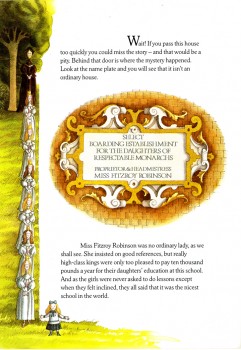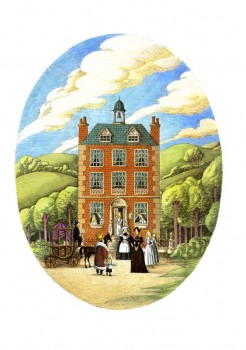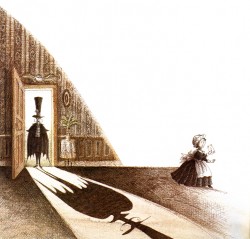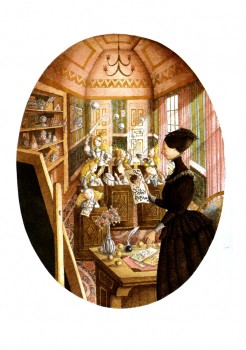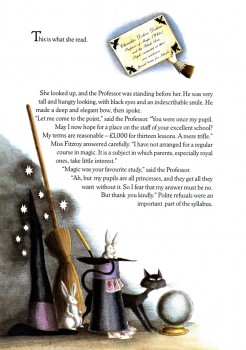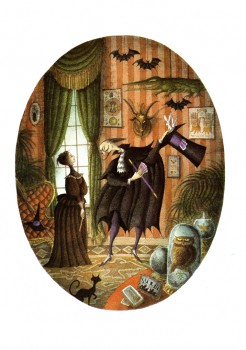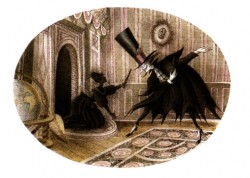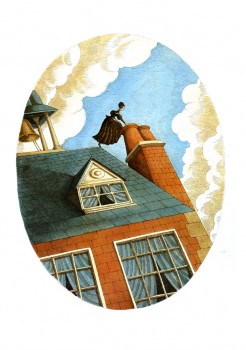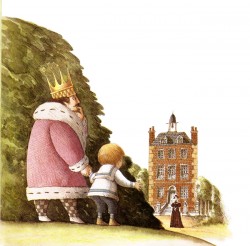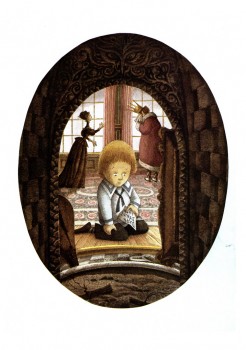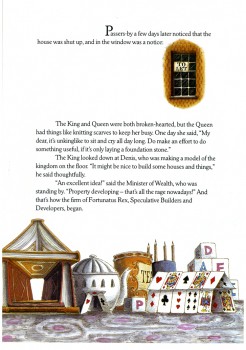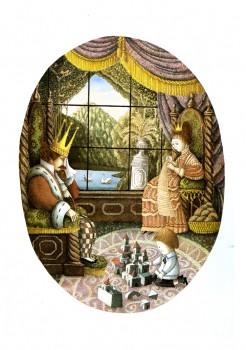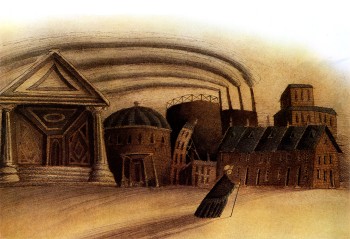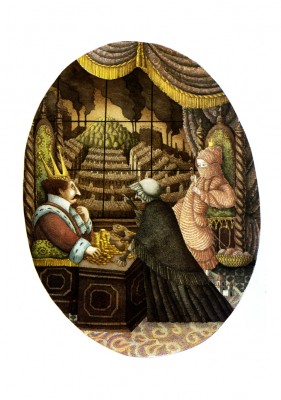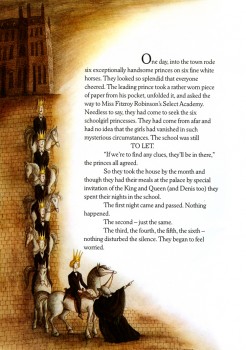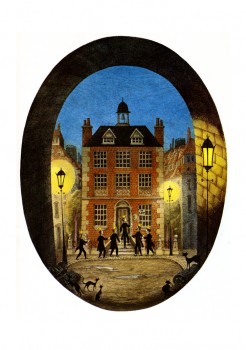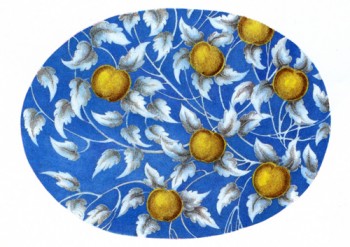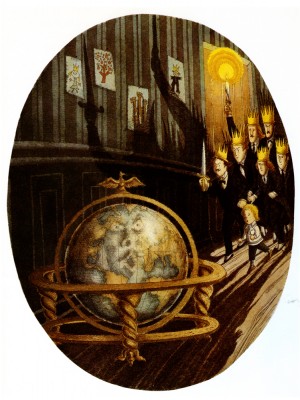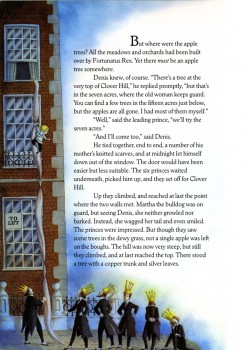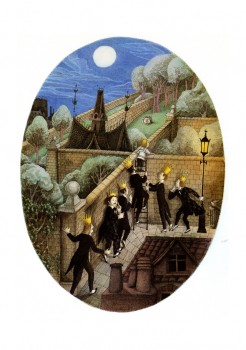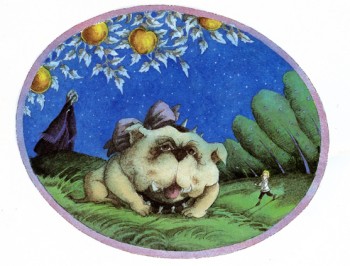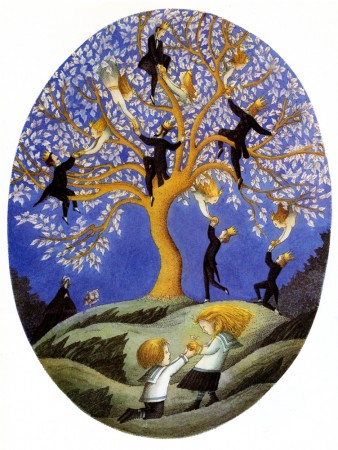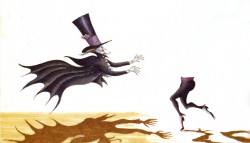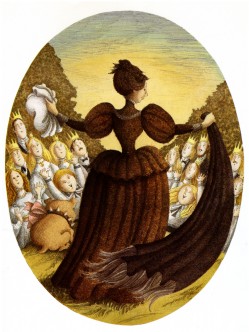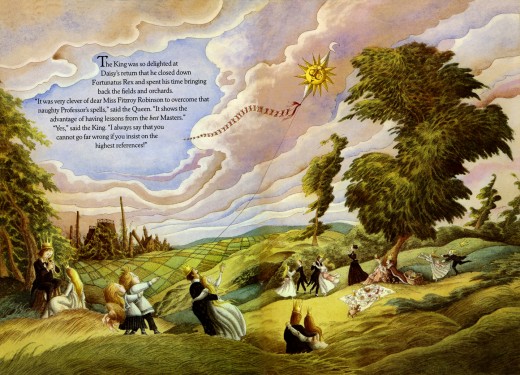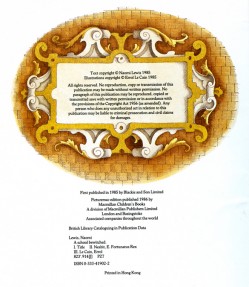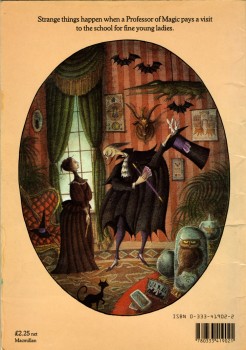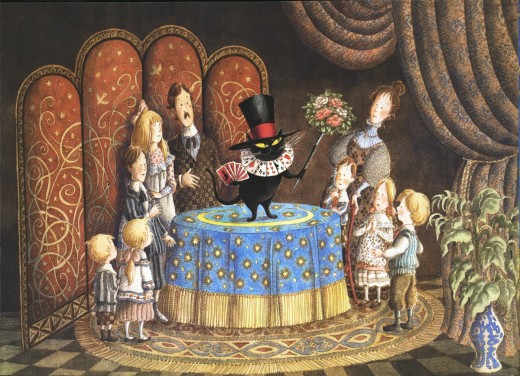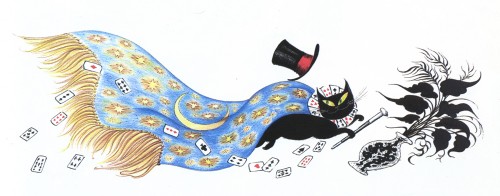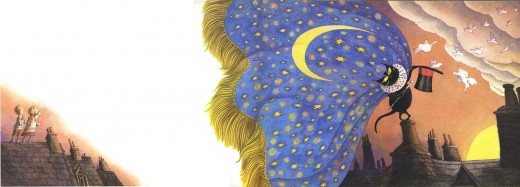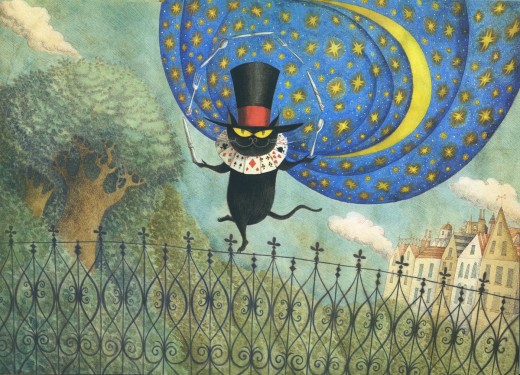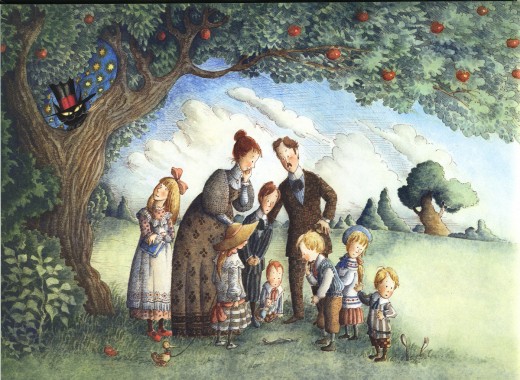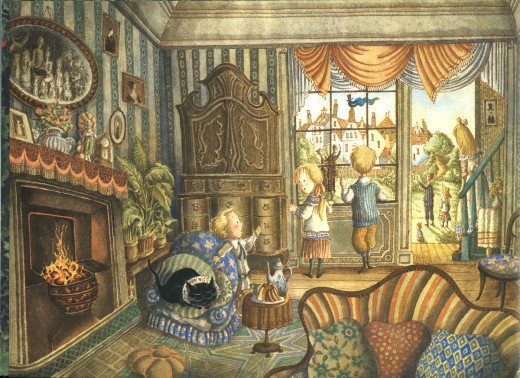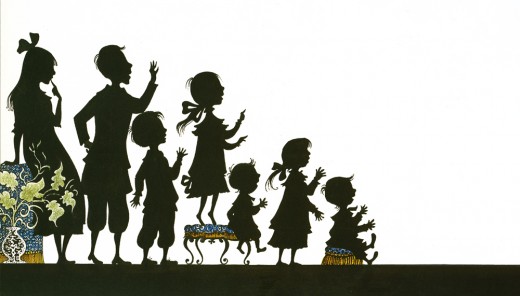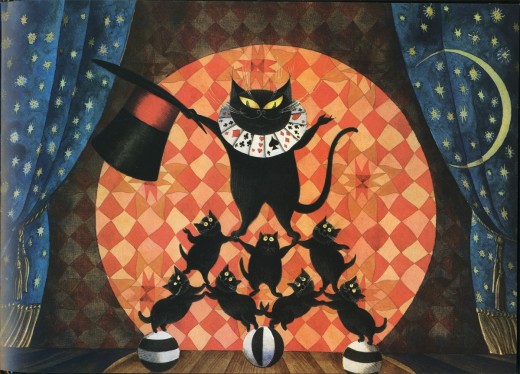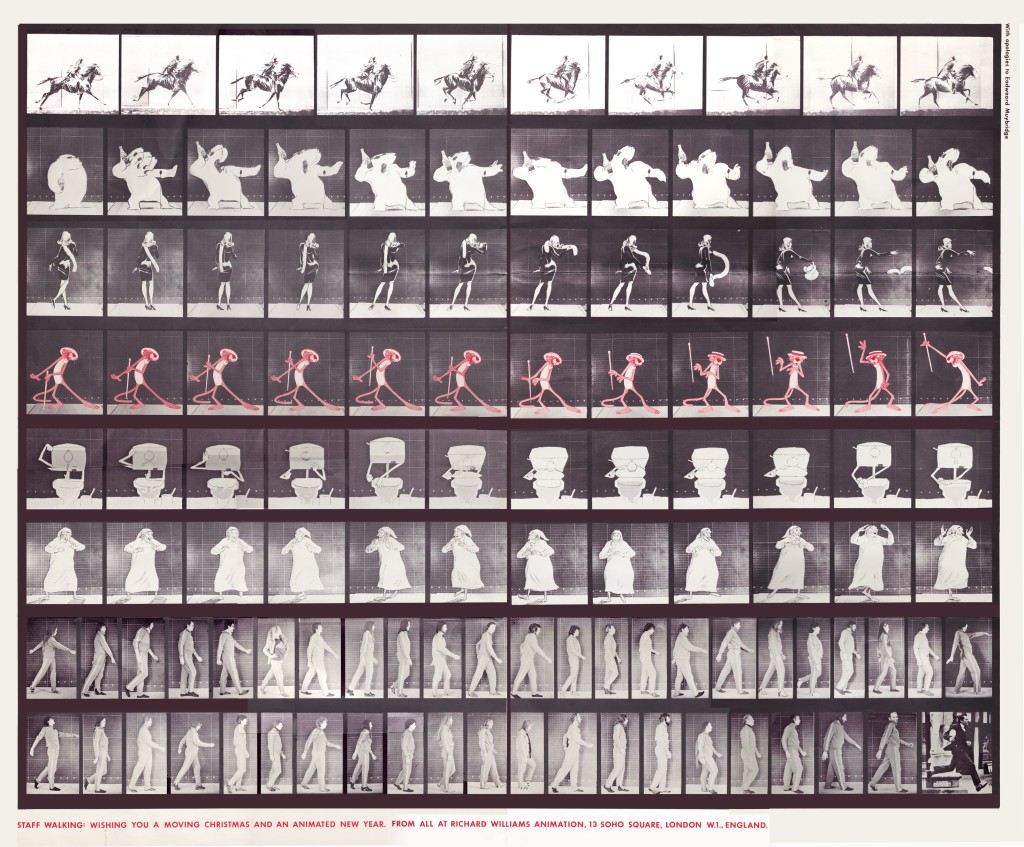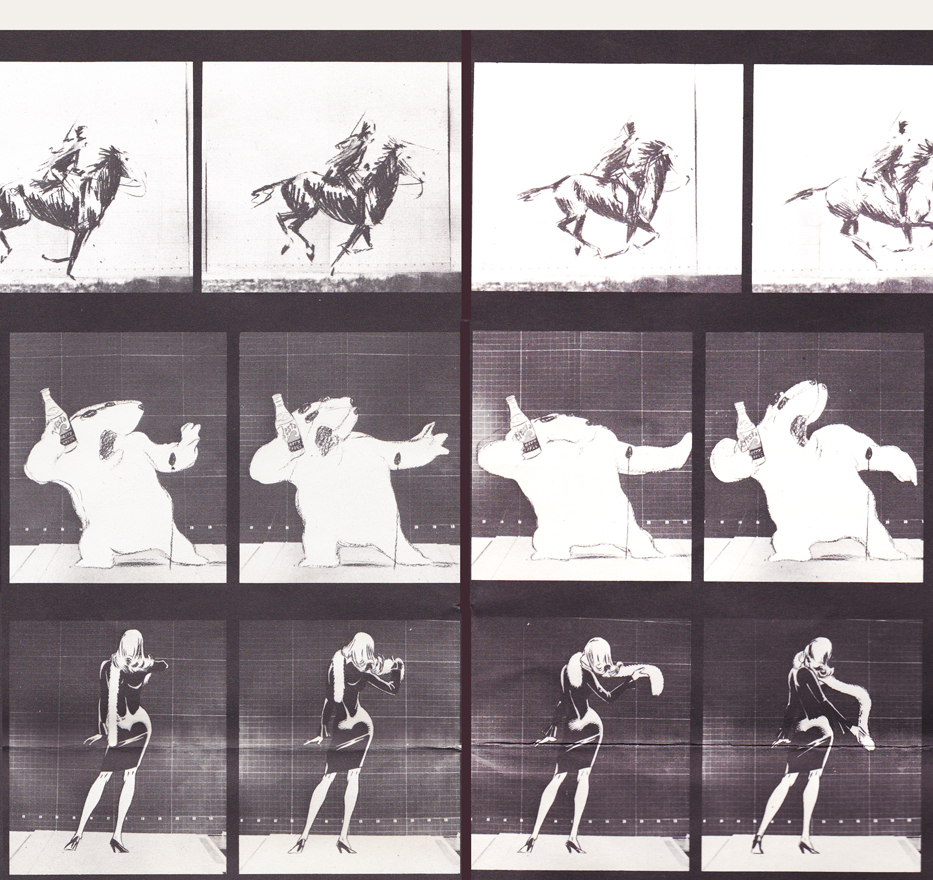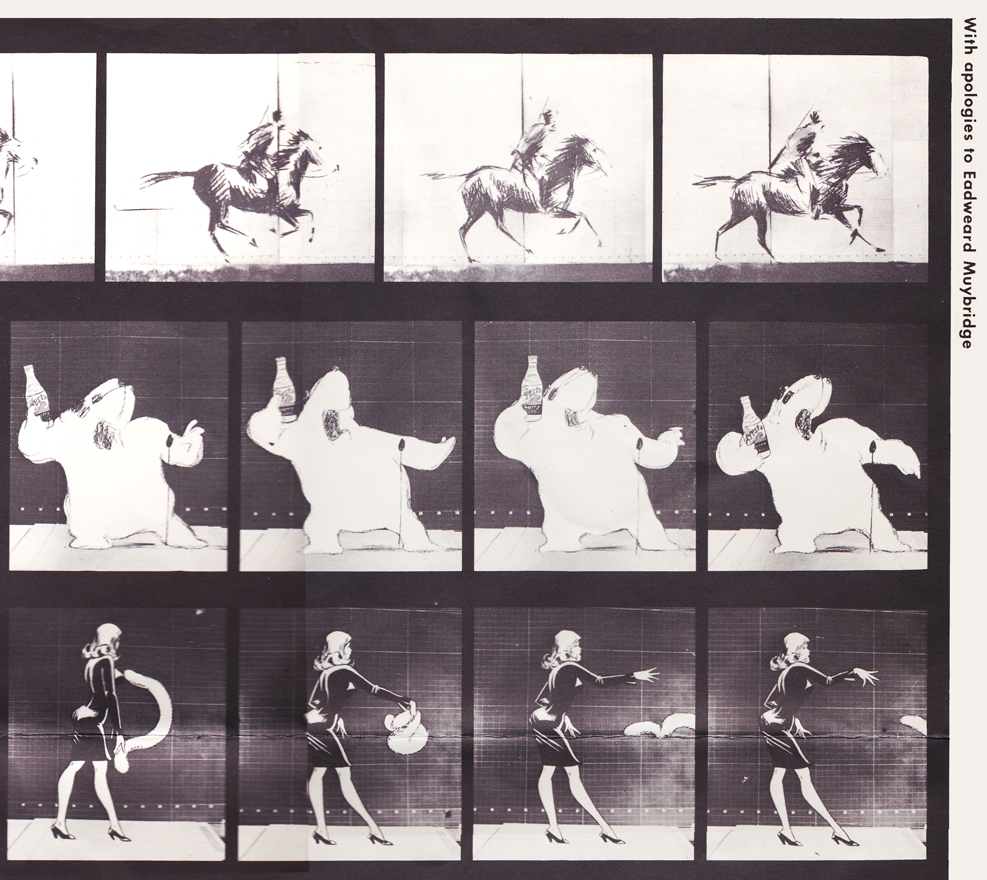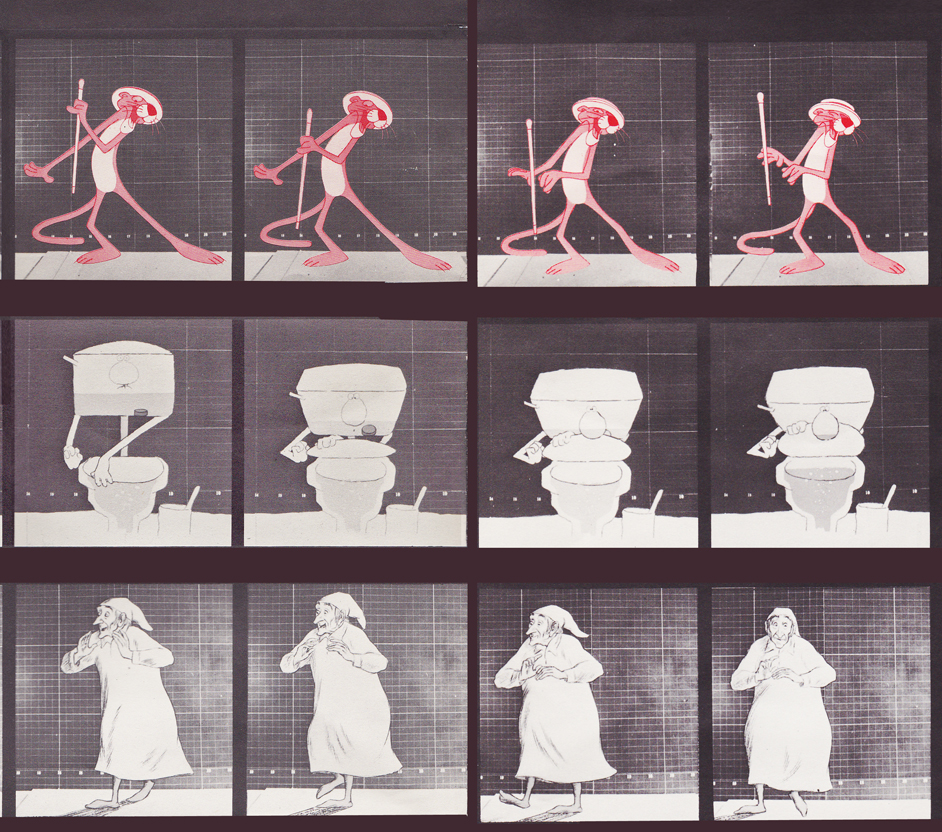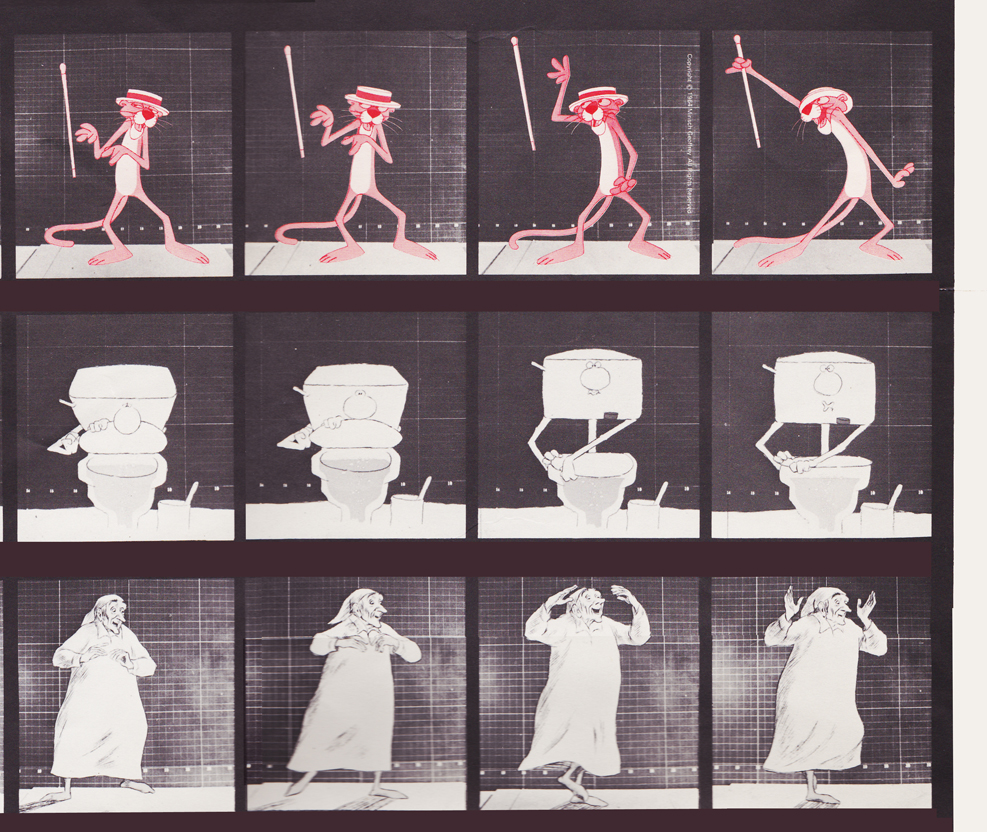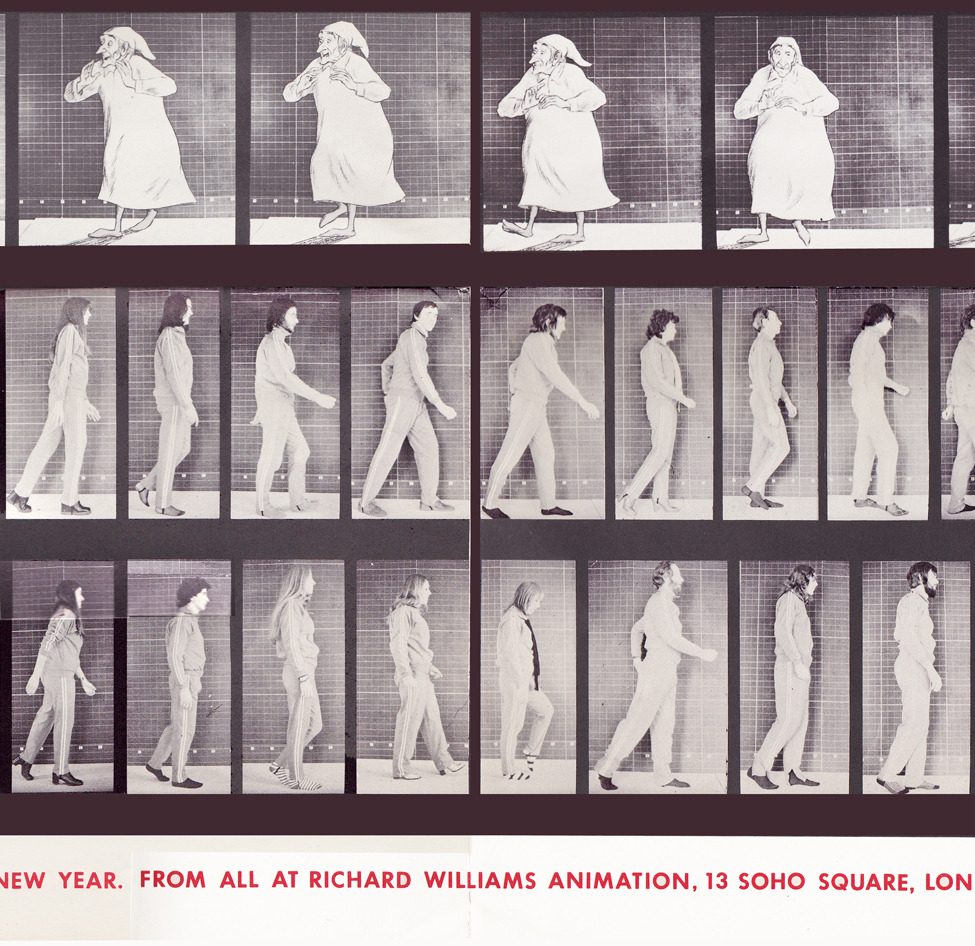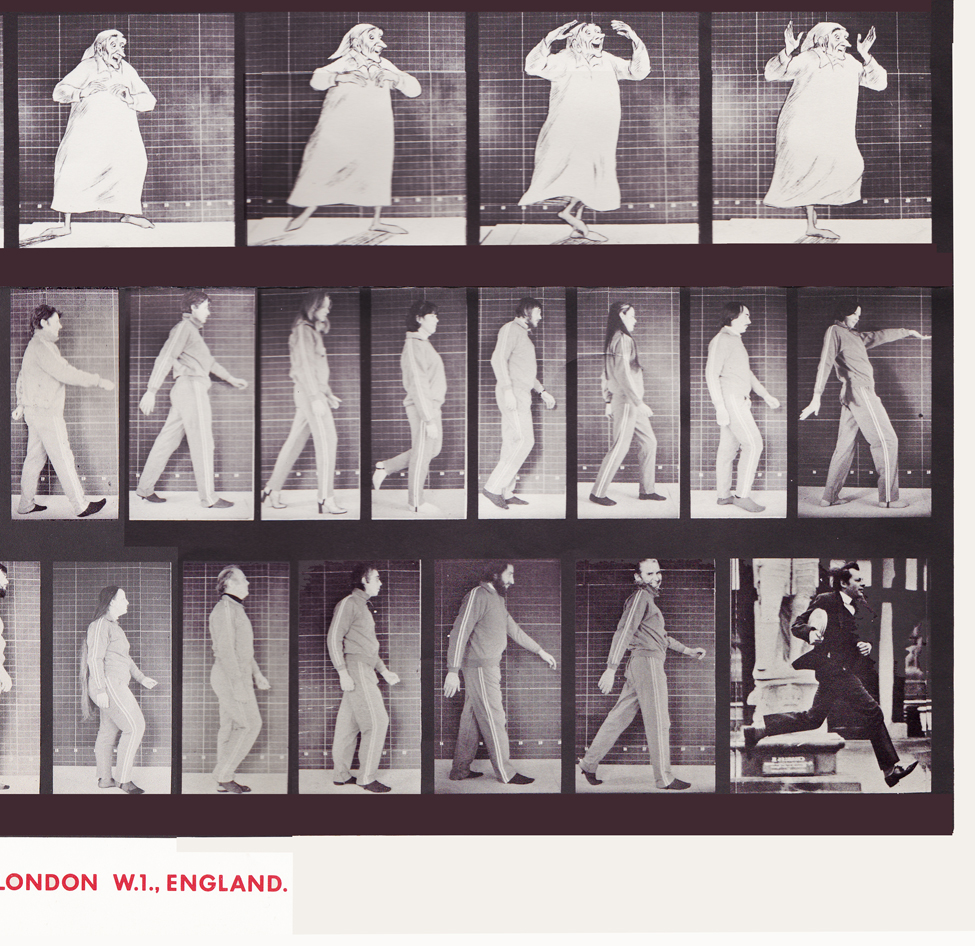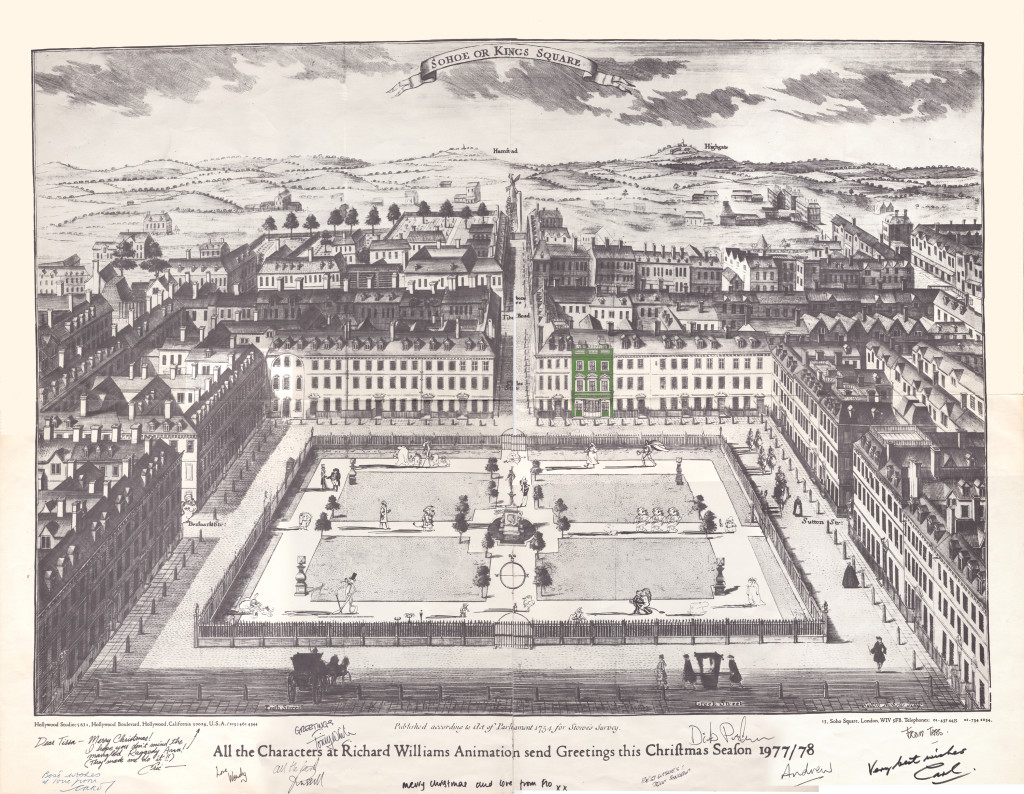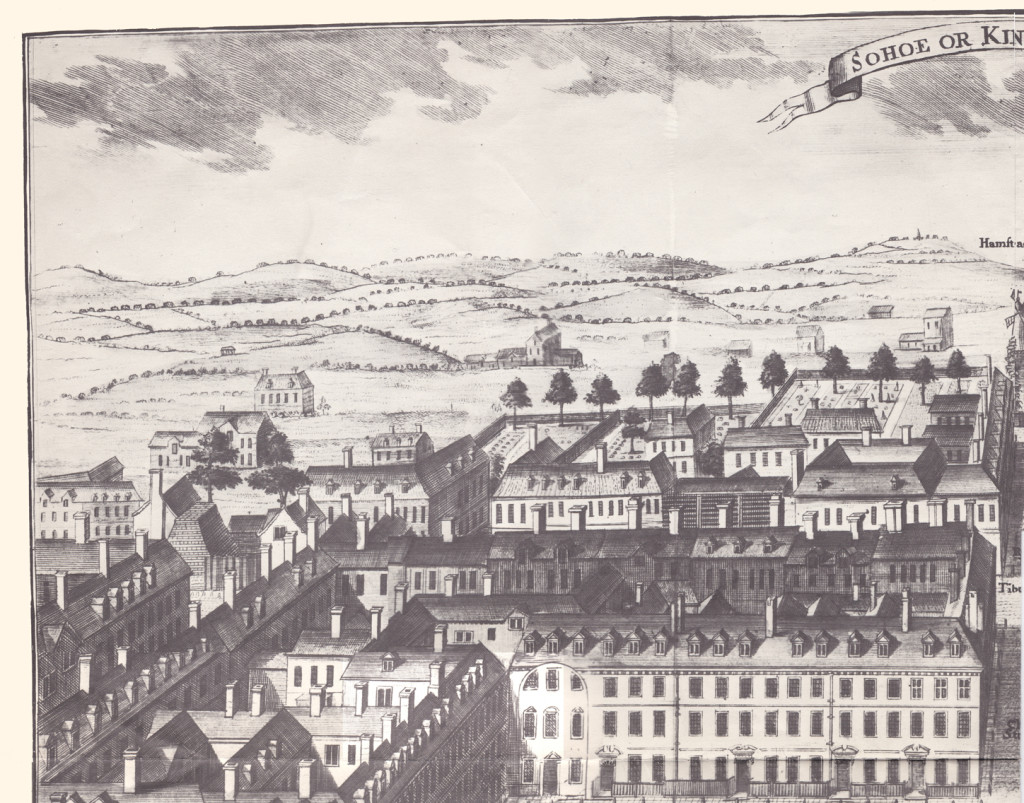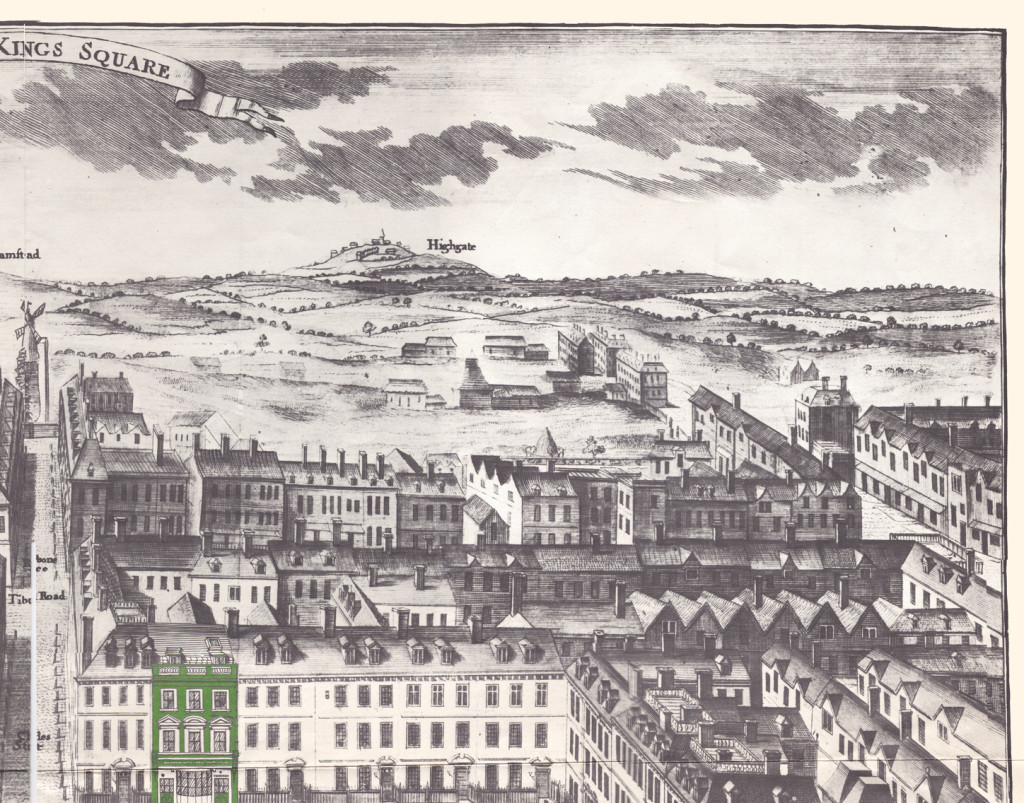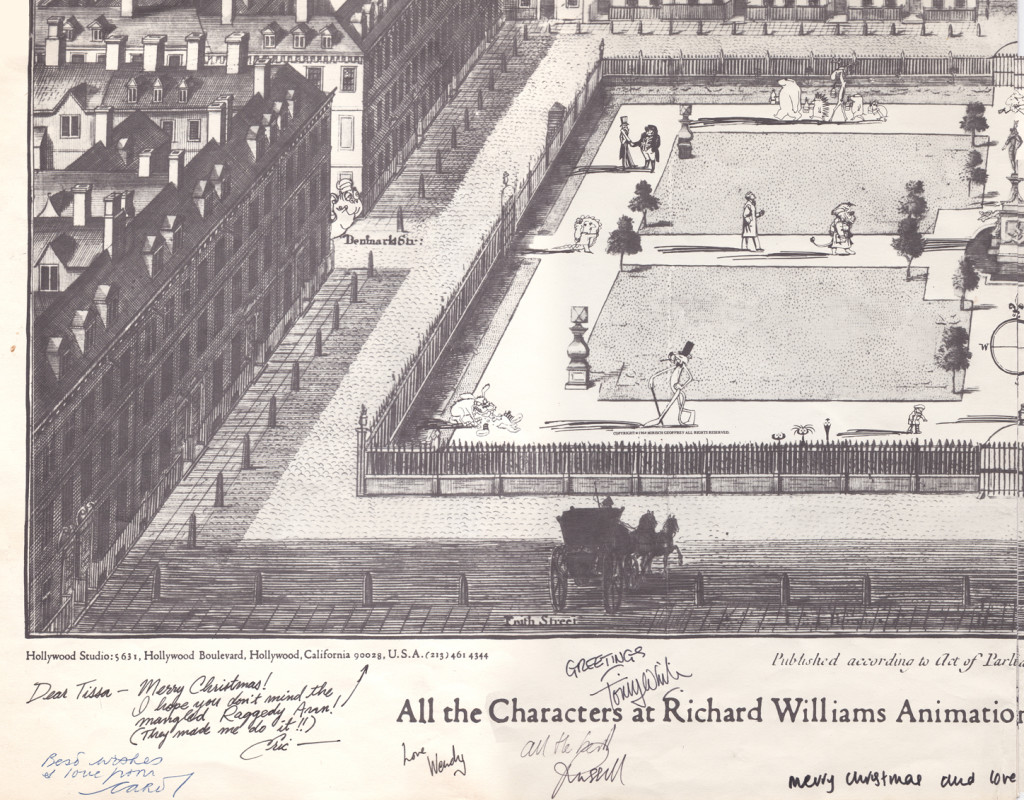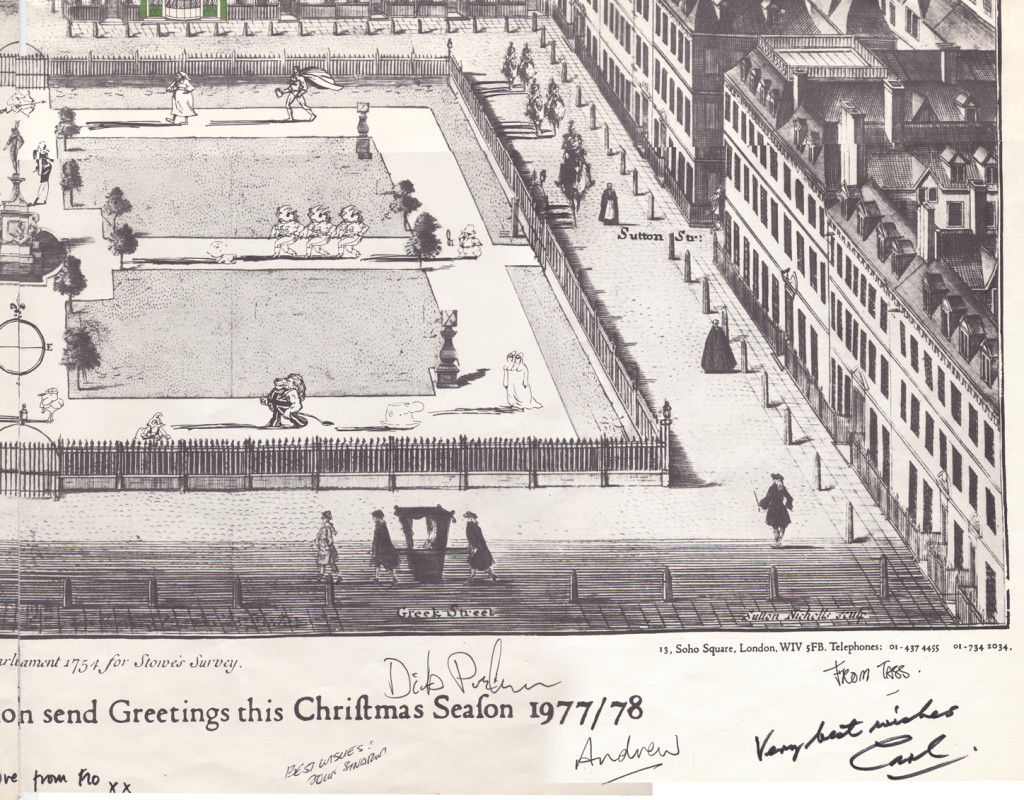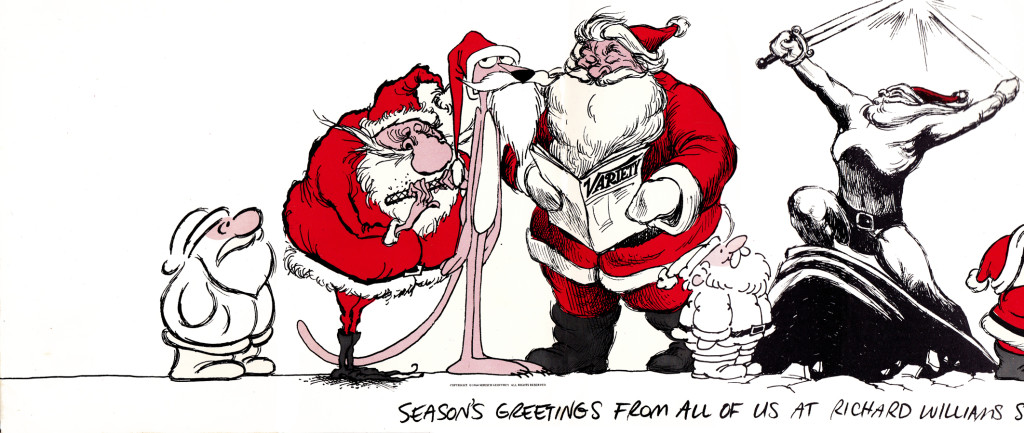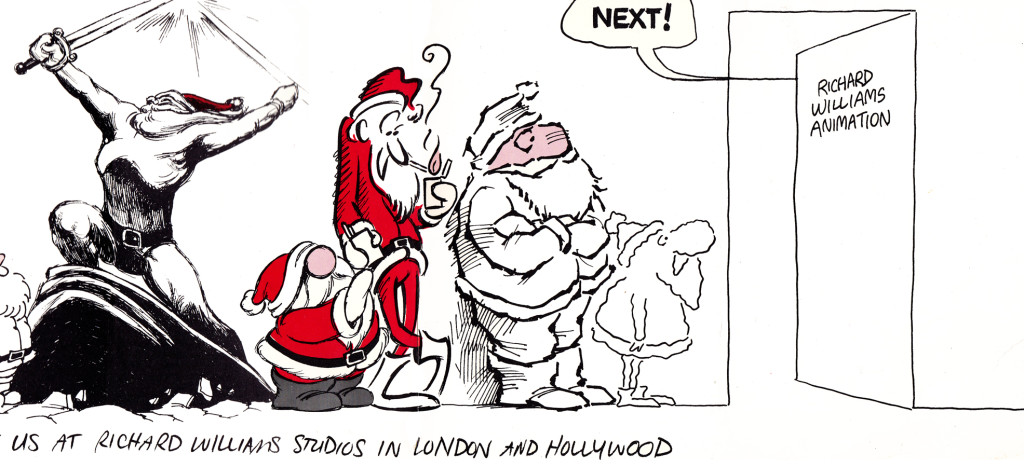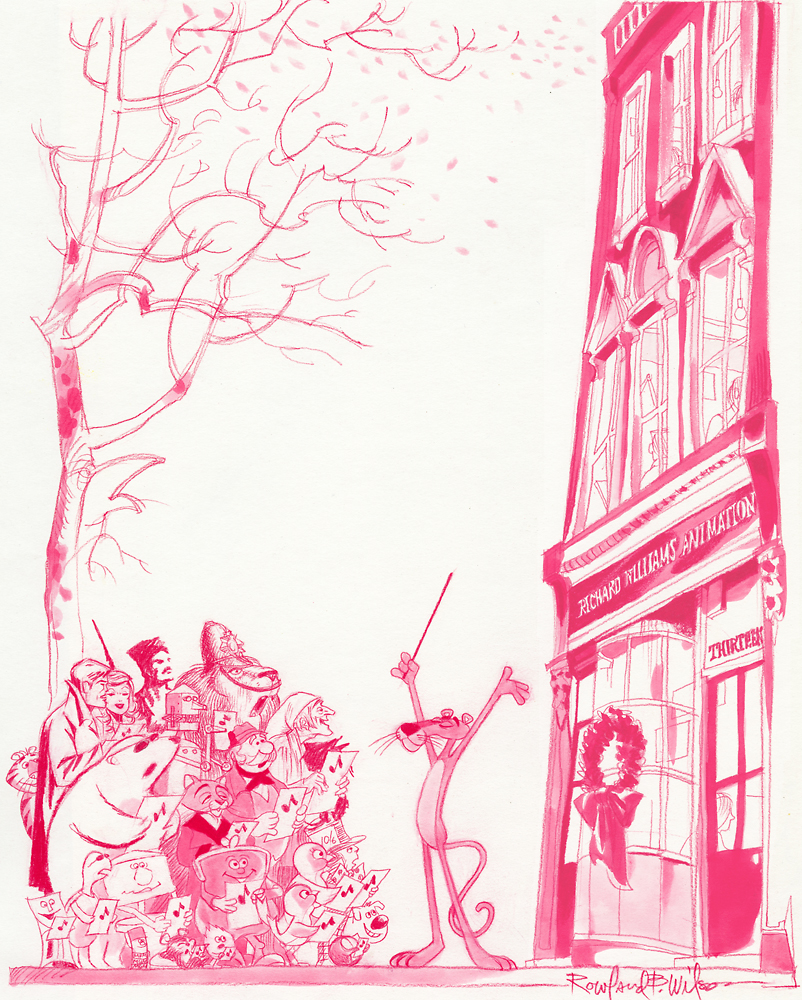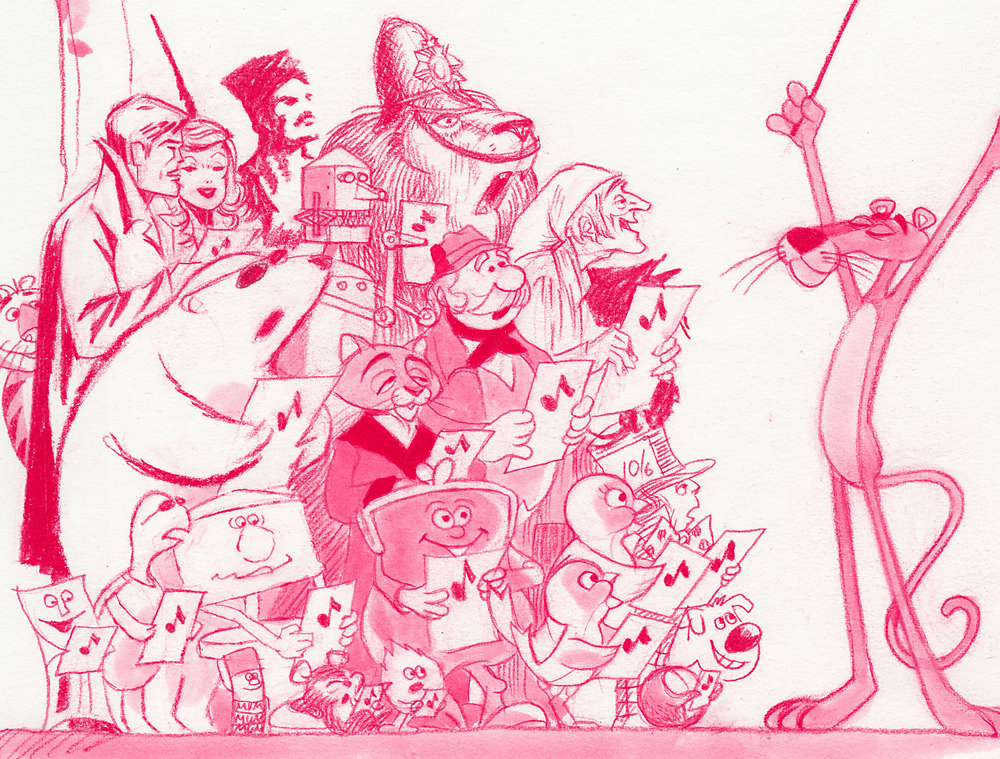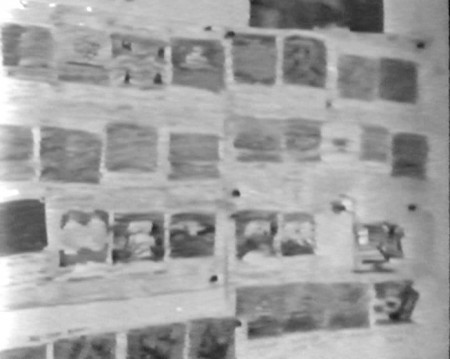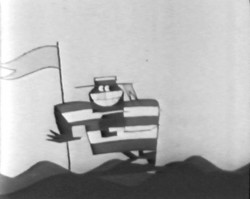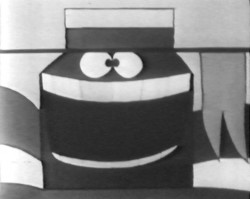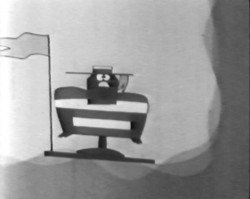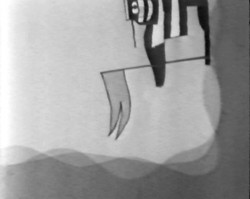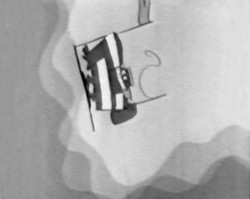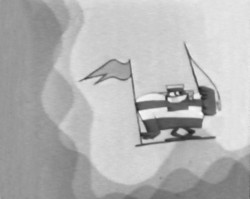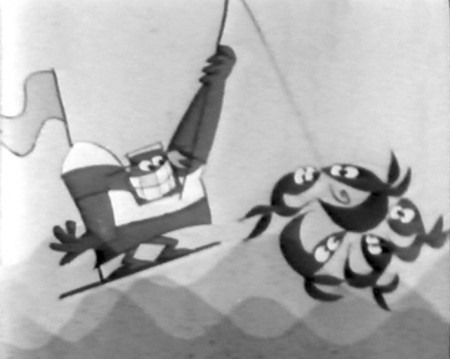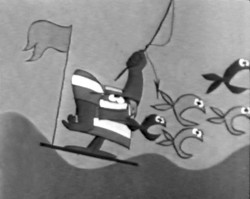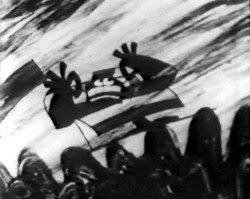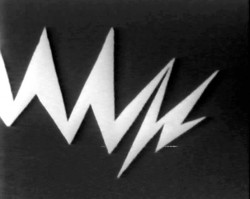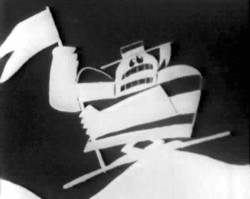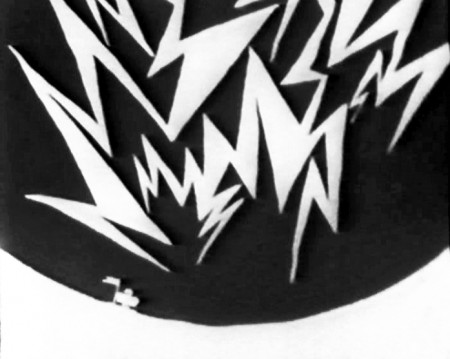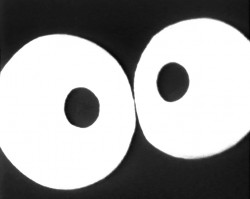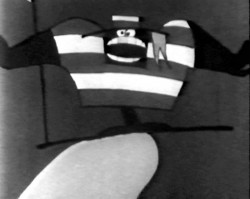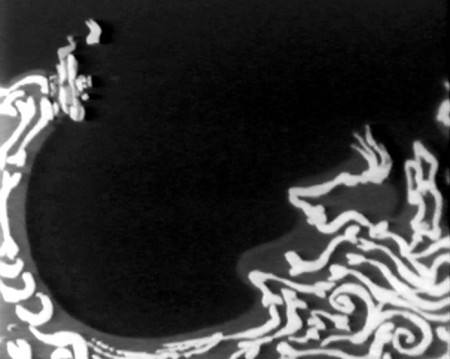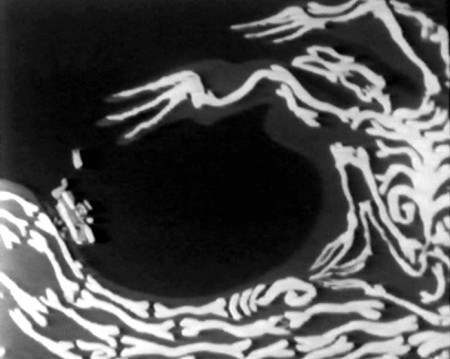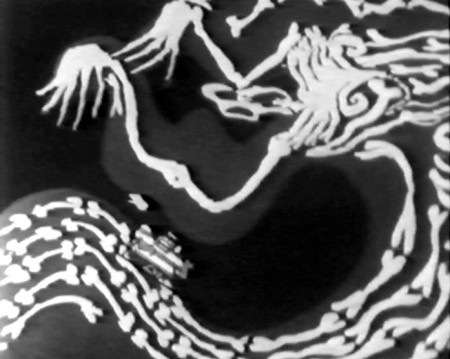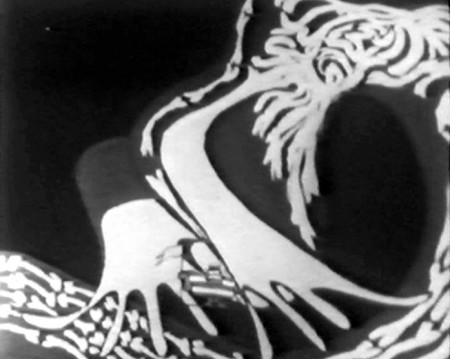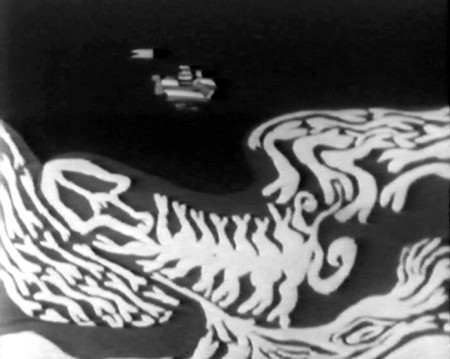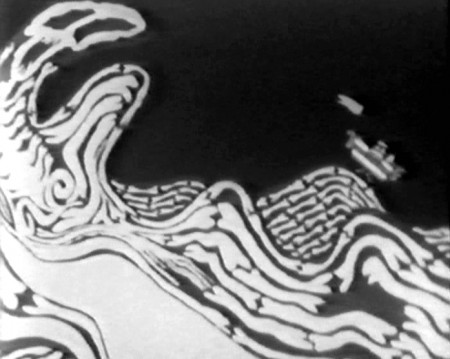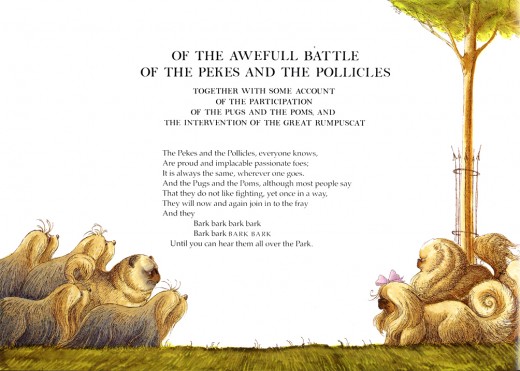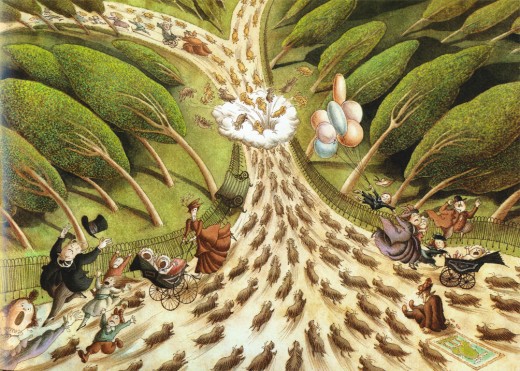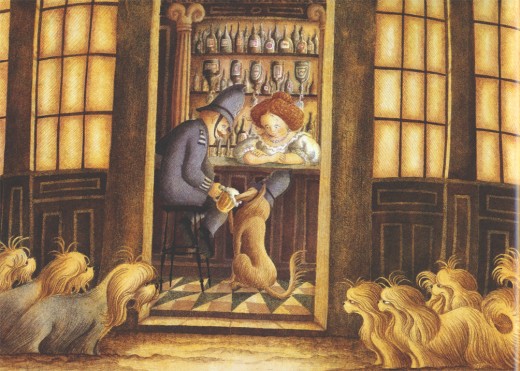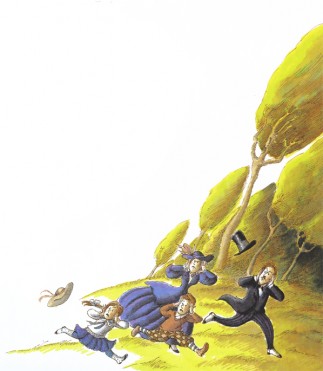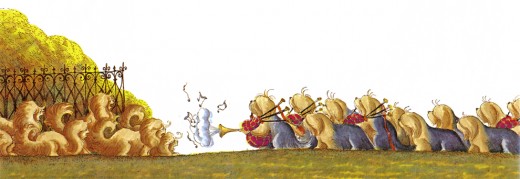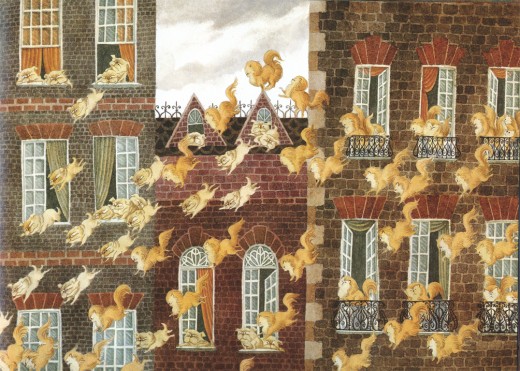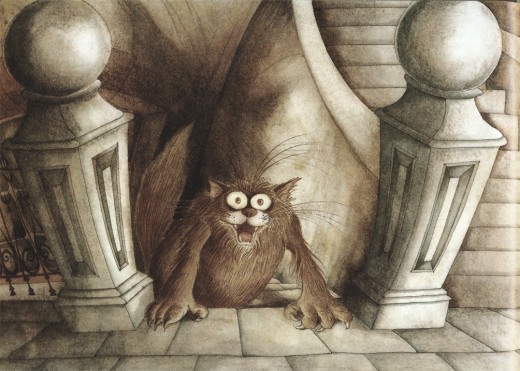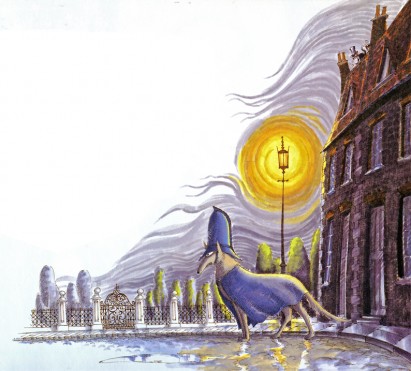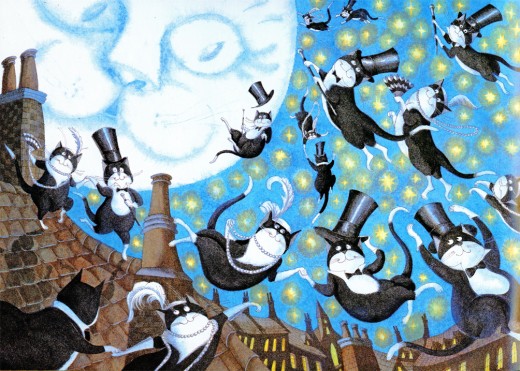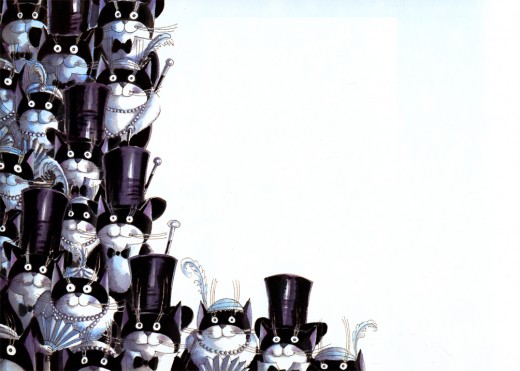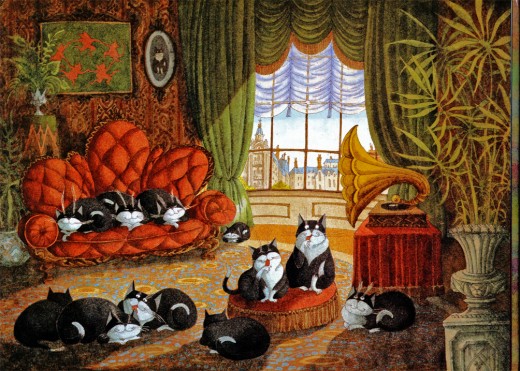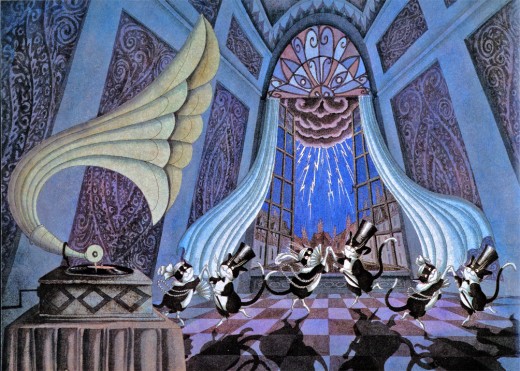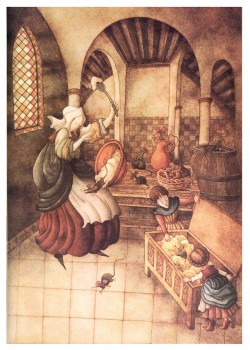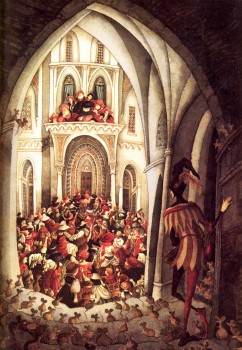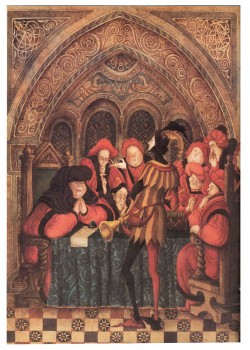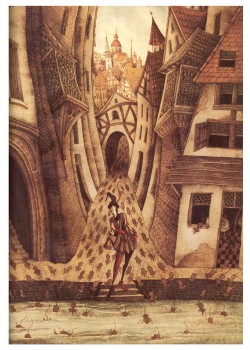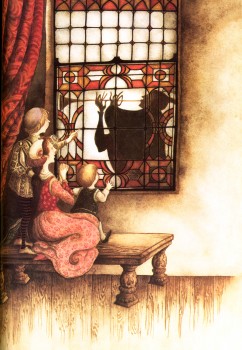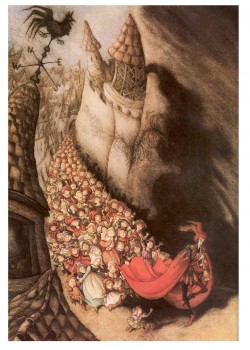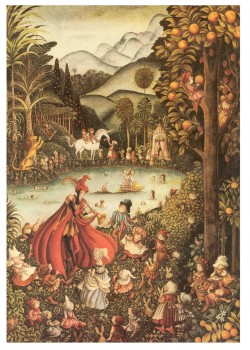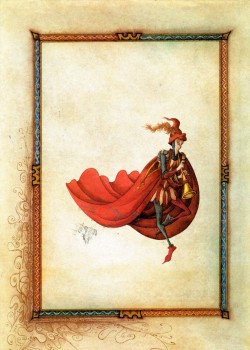Category ArchiveErrol Le Cain
Books &Errol Le Cain &Illustration 16 Aug 2013 07:08 am
A School Bewitched by Errol le Cain
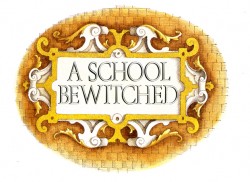 - As you know, I am an enormous fan of Errol Le Cain’s work. I’ve been posting quite a few of his illustrations for children’s books. (You can see the past posts, if you’re interested, here.)
- As you know, I am an enormous fan of Errol Le Cain’s work. I’ve been posting quite a few of his illustrations for children’s books. (You can see the past posts, if you’re interested, here.)
Today, I’m showcasing a book written by Naomi Lewis from a story by E. Nesbit.
The book was adapted to a film on the BBC, narrated by Nigel Havers. She also adapted The Snow Queen which Le Cain illustrated.
The book contains 30 pages, and every page includes an illustration. I’ve decided to break this into two parts since I don’t want to post tiny thumbnails of the pictures.
I’m not highlighting the text; you’ll have to buy the book for that. I am posting all the great illustrations and hope you enjoy them as much as I do.
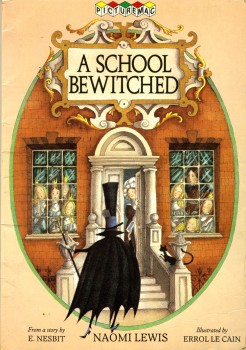 __
__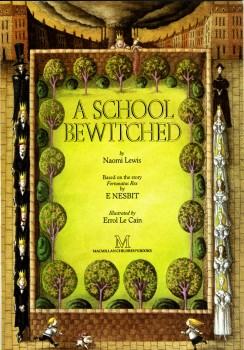 1
1(Click any image to enlarge.)
A School Bewitched is a small picture book with a full page illustration on every other page. The remainder have spots which decorate around the type.
We started showing off the illustrations yesterdayl here are more. I’m not concerned with telling the story. I’d urge you to buy the book if you’re interested in that.
______(Click any image to enlarge.)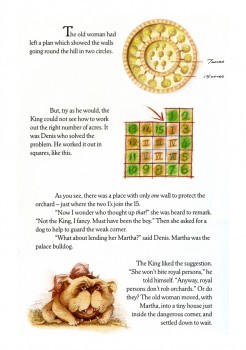 16
16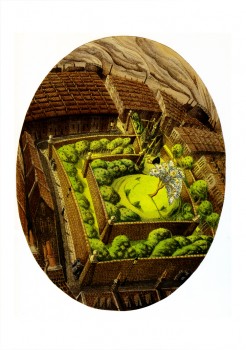 17
17
Books &Errol Le Cain &Events &Festivals &Illustration &repeated posts 17 Jun 2013 04:52 am
Mr. Mistoffelees – repost
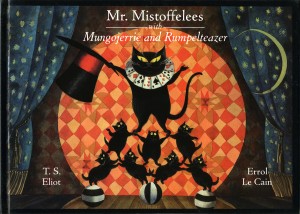 – I’ve posted many of Errol Le Cain‘s illustrations for his children’s books. Ever since coming across that very first paper-bound book, about Briar Rose, (meaning it was the very first I’d seen for sale) I’ve been an avid collector searching out any of the many books he created.
– I’ve posted many of Errol Le Cain‘s illustrations for his children’s books. Ever since coming across that very first paper-bound book, about Briar Rose, (meaning it was the very first I’d seen for sale) I’ve been an avid collector searching out any of the many books he created.
Le Cain was my hero for quite some time. He was a student of Dick Williams’ studio, had learned to animate there and was doing the backgrounds for Dick’s feature The Thief and the Cobbler. Dick pushed him, at one time, to do a film on his own, The Sailor and the Devil, with, of course, Dick’s harsh scrutiny.
I present here his illustrations for the first half of the book, Mr. Mistoffelees with Mungojerrie and Rumpelteazer. The latter half of the book included the Mungojerrie and Rumpelteazer part which we’ll save for another time.
This story is part of the Old Possum’s Book of Practical Cats by T.S. Eliot.
That was, of course, the source material on which Webber and Nunn based their show CATS. These images are so attractive and stylish, I was quite curious to know whether Andrew Lloyd Webber had seen the books. Especially when he was about to put CATS onto the screen as an animated film.
Here are the illustrations by Le Cain:
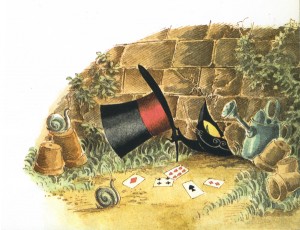
________ (Click any image you’d like to enlarge.)
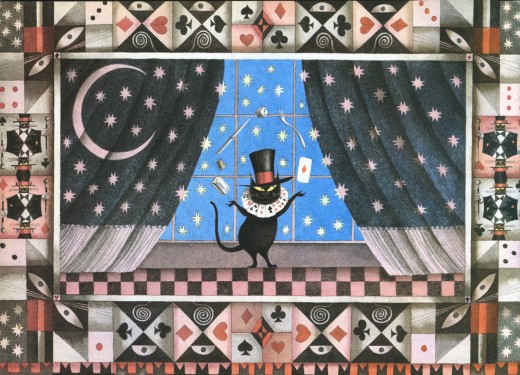
_____________Mr. Mistoffelees
___________You ought to know Mr. Mistoffelees !
___________The Original Conjuring Cat -
___________(There can be no doubt about that).
___________Please listen to me and don’t scoff All his
___________Inventions are off his own bat.
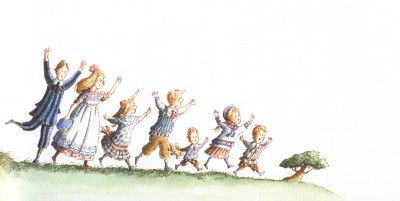
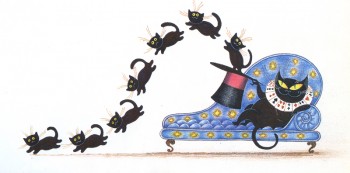
commercial animation &Errol Le Cain &Illustration &Independent Animation &repeated posts &Richard Williams &Rowland B. Wilson &Tissa David 10 Apr 2013 05:55 am
Dick’s Christmas
Richard Williams, when he had his own studio, was known for doing everything in a LARGE way. All of the commercials, title sequences, shorts were all done with a large, elaborate vision.
The Charge of the Light Brigade was a collection of 19th century graphics that are completely wrong, stylistically, for animating. All those cross-hatched lines. God bless the artists that pulled that off. The same was true for The Christmas Carol.
If the rendering style wasn’t impossibly difficult, then the animation was complex. Think of any of the scenes from Dick’s dream-feature, The Thief and the Cobbler. The many scenes where backgrounds were animated, with those backgrounds complete with complicated floor patterns or an entire city to be animated. Raggedy Ann was covered in polka dots and Andy was clothed in plaids. Both of the characters had twine for hair with every strand delineated. The commercial for Jovan featured a picture-perfect imitation of a Frank Frazetta illustration. Even the mountain on the background had to be animated and rendered.
Well, when it came to Christmas cards, Richard Williams was the same. Enormous and beautiful cards were printed and signed by anyone who knew the recipient of the card. You were lucky being on the receiving line for these stunning cards. Tissa David once gave me a number of these cards. I held onto my copies of the cards until my space was flooded and the cards were damaged. I thought I’d post a few.
With card #1, a take-off of Muybridge with frame grabs from several of the better Williams commercial spots from that year, capped off by a number of key staff personnel positioned to continue the Muybridge motif.
(Here, I first post the entire card, followed by a break up of the card into sections
so you can more ably see the details.)
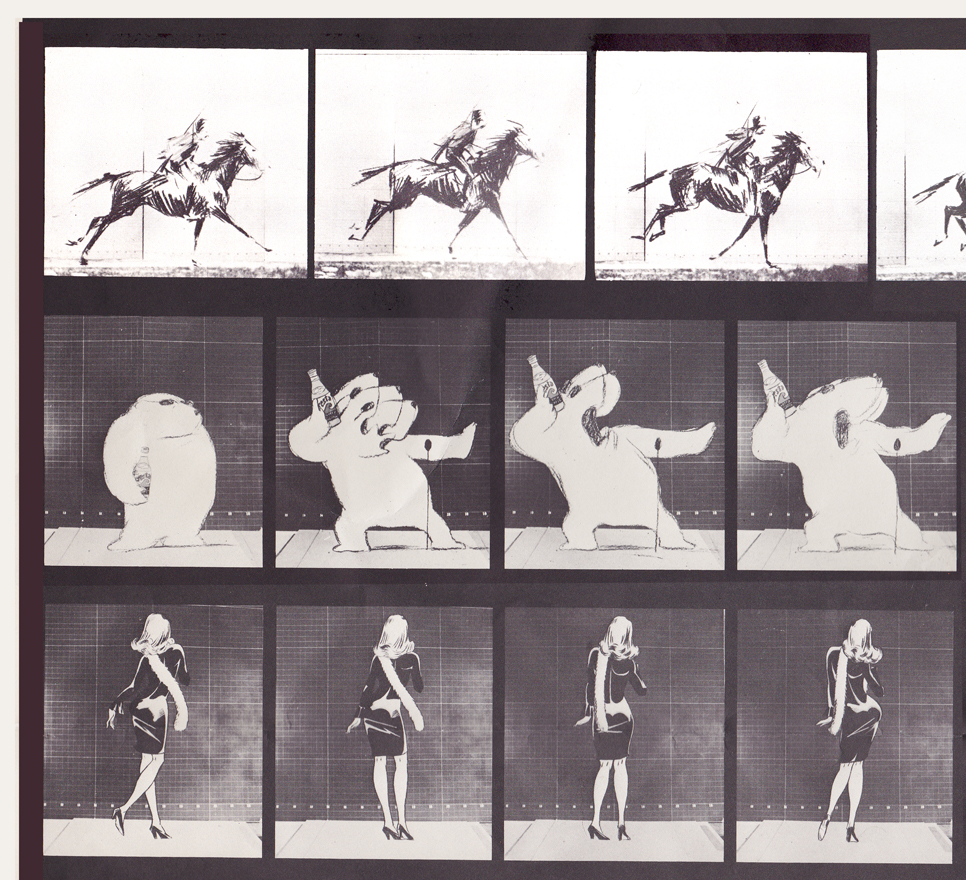
Top rows left side / Row 1: Pushkin Vodka ad
Row 2: Cresta Bear ad / Row 3. Tic Tac ad
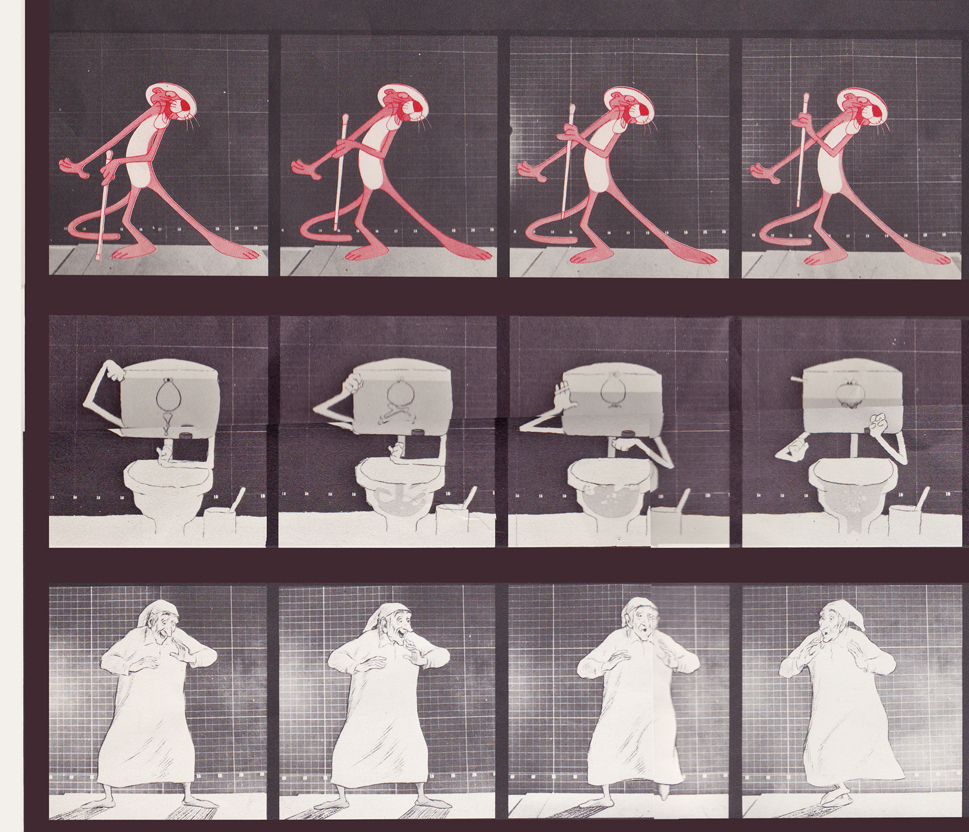
Middle rows left side / top row: Pink Panther titles
Middle row: Bloo toilet cleanser ad / Bot row: The Christmas Carol
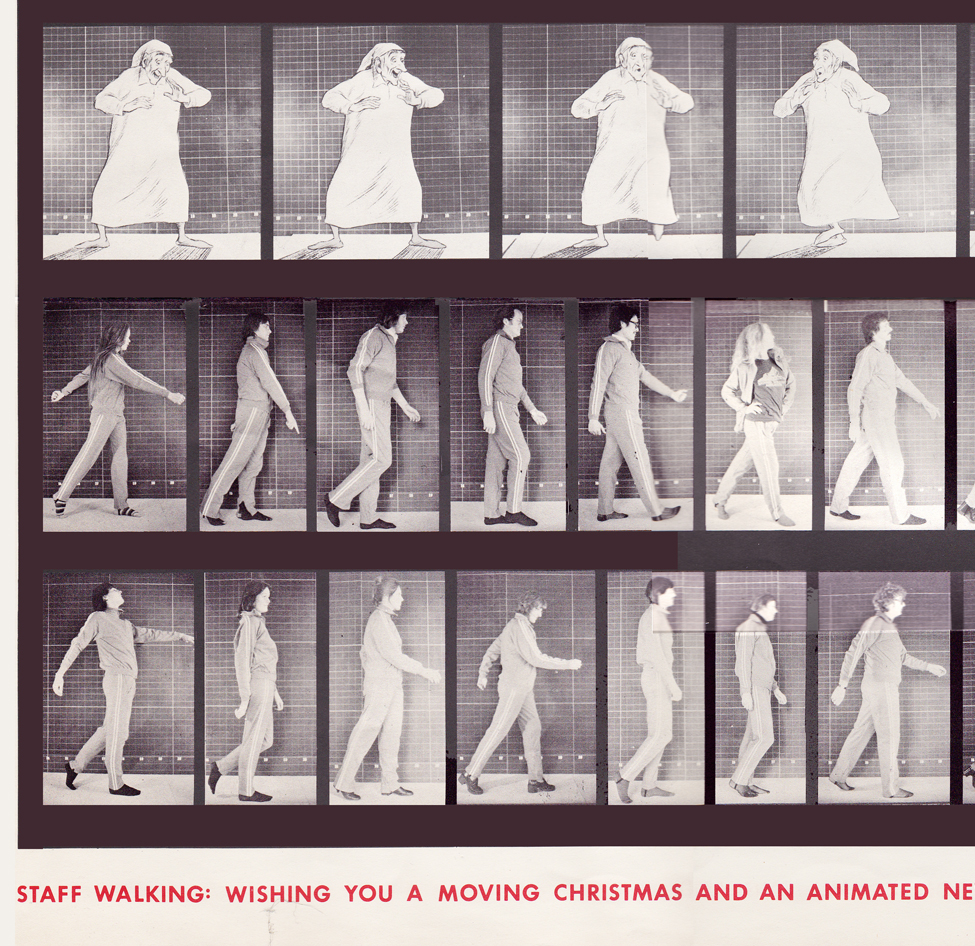
Bottom rows left side / top row: The Christmas Carol (repeated)
Middle row: staff / bottom row: more staff
With card #2 we see Soho Square. The green front door
marks the location of Dick’s studio at 13 Soho Square.
(As with the first card, I posted the entire Christmas card,
followed by a sectional divide so you can enjoy the details.)
This is a folding card.
It comes folded so that you see the far left of the card
revealing part of the far right.
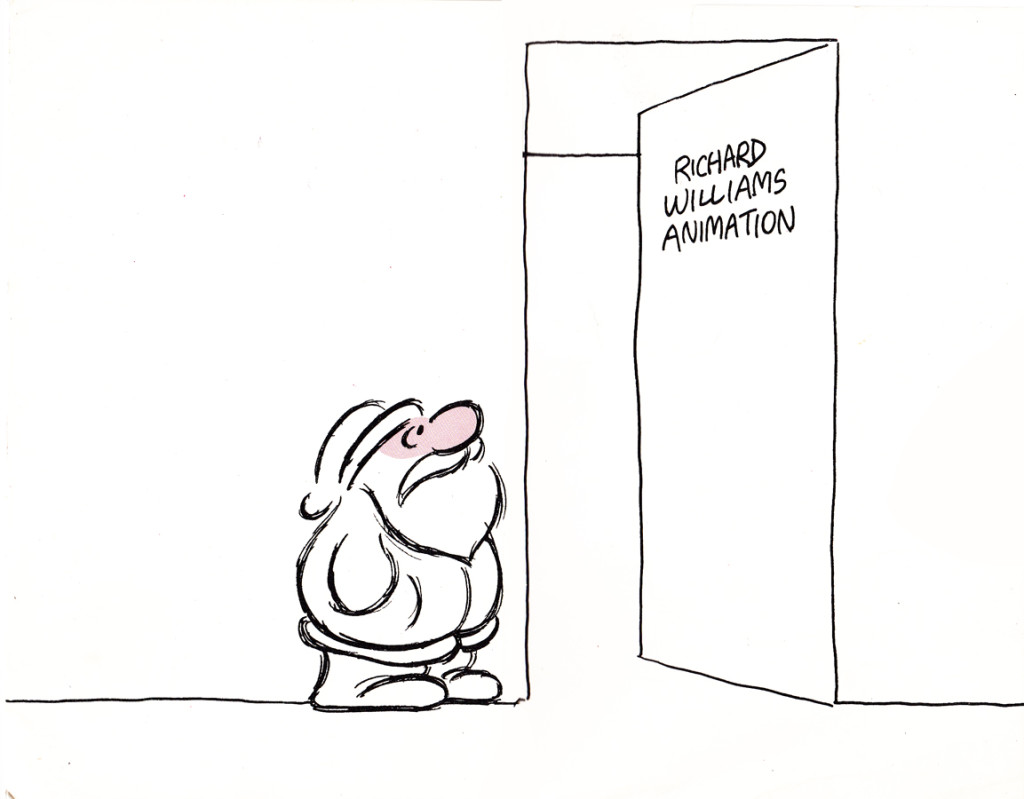
The card comes folded like this.
The left side (Santa up to doorway) is on the left side of the card.
The right side, on bottom, reveals the empty office.

It unfolds to reveal this long line of Santas.
Each Santa is in the style of the many illustrators’ styles
of those who designed ads for the studio in the prior year.
Suzanne Wilson sent in a Pink Panther Chistmas card; it was drawn by her late husband Rowland Wilson:
Below is a close up of that same card.
Here’s another full card.
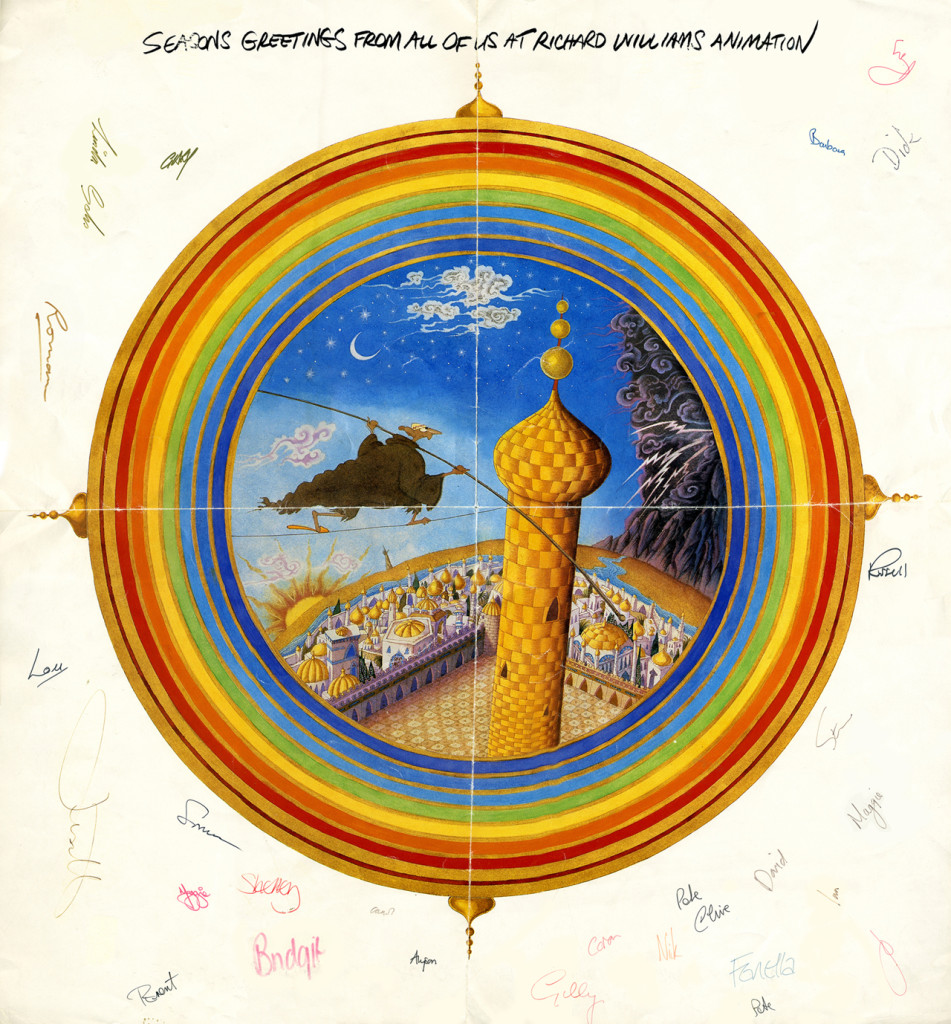
This one is designed after the McGuffin of Dick’s feature,
three golden balls over the city.
from The Thief and the Cobbler.
Animation &Commentary &Daily post &Errol Le Cain &Richard Williams 25 Feb 2013 05:28 am
POV
Next Friday, at the invitation of filmmaker-editor-director, Kevin Schreck, I’ll have the pleasure of seeing his recently completed documentary, Persistence of Vision. This is the story of the making of Richard Williams‘ many-years-in-the -making animated feature, The Cobbler and the Thief. I’m not sure of the film maker’s POV, but I somehow expect it to be wholly supportive of the insistent vision of Richard Williams in the making of this Escher-like version of an animated feature. A work of obsession.
It’s the tale of an “artist”, someone who sees himself as an artist, and continually pushes through the world with what would seem to be evident proof of such. After all, this man had single-handedly altered the face of 2D animation in a world that was about to throw it away with all its rich history and artistry and strengths. A medium that had developed through the years of Disney with giant, filmed classics such as Snow White, Pinocchio, Fantasia and even Sleeping Beauty. A medium that had drastically changed to 20th century graphics under the hands of people like John Hubley, Chuck Jones, George Dunning and many others and had just about reached a zenith where it was moving toward something wholly new, something adult.
Instead the medium took a turn in the wrong direction. The economics of television brought us back almost 100 years as films became more and more simplistic and simpleminded in the rush to be cheap. Even the Disney studio went for the poorest subject matter using cost-saving devices to sell their films. Films became shoddier and shoddier, and the economics ruled. The closest the medium would come to art was Ralph Bakshi‘s Fritz the Cat and Heavy Traffic, low budget movies that traded on racy material in exchange for an attempt at something adult, stories barely held together with editing tape. Animation was getting a bad name from every corner whether it was the sped-up graphics of Hanna-Barbera, the reach to the lowest common denominator with poor animation from Disney, or the shock and tell of Ralph Bakshi‘s filmed attempts at what he saw as art.
Williams took a different turn. He went back to the height of animation’s golden era, inviting artists such as Grim Natwick, John Hubley, Ken Harris and Art Babbitt to his London studio to lecture on the rules and backbone of the animation. He brought some of these people to work on a feature that he’d decided to create within his studio on the profits of commercials. These very same commercials financed the training of Dick and his young staff.
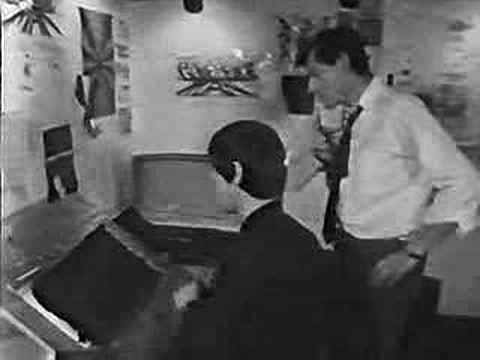 A documentary done in 1966, called The Creative Person: Richard Williams offers an excellent view of his studio. We see snippets of shorts Dick made with his own coin: Love Me Love Me Love Me (1962) or The Sailor and the Devil (1967) wherein we see the training of a young and brilliant illustrator named Errol le Cain. (Le Cain became known for his magnificent, glimmering children’s book illustrations. He was doing most of the backgrounds for The Cobbler and the Thief, and had certainly had a large part in its design.)
A documentary done in 1966, called The Creative Person: Richard Williams offers an excellent view of his studio. We see snippets of shorts Dick made with his own coin: Love Me Love Me Love Me (1962) or The Sailor and the Devil (1967) wherein we see the training of a young and brilliant illustrator named Errol le Cain. (Le Cain became known for his magnificent, glimmering children’s book illustrations. He was doing most of the backgrounds for The Cobbler and the Thief, and had certainly had a large part in its design.)
 We see in this documentary the first hint of The Cobbler when it was called Nasruddin. It was based on a book of middle eastern tales of a wise fool whose every short story tells a new and positive anecdote. Dick had illustrated several books of these tales with many funny line drawings. The book was written by the Idres Shah who had undertaken a role within the Willams studio finding funds for the feature. Eventually, the two had a falling out, and Idres Shah left with his property. Williams took the work he had done as Nasruddin and reworked it into The Cobbler and the Thief. ________________________________Errol le Cain
We see in this documentary the first hint of The Cobbler when it was called Nasruddin. It was based on a book of middle eastern tales of a wise fool whose every short story tells a new and positive anecdote. Dick had illustrated several books of these tales with many funny line drawings. The book was written by the Idres Shah who had undertaken a role within the Willams studio finding funds for the feature. Eventually, the two had a falling out, and Idres Shah left with his property. Williams took the work he had done as Nasruddin and reworked it into The Cobbler and the Thief. ________________________________Errol le Cain
Meanwhile the work within his studio continued to develop, growing more and more mature. The commercials became the highlight of the world’s animation. Doing many feature film titles such as What’s New Pussycat (1965), A Funny Thing Happened on the Way to the Forum (1966), The Charge of the Light Brigade (1968) led to Dick’s directing a half-hour adaptation of The Christmas Carol (1971). Chuck Jones produced the ABC program, and it led to an Oscar as Best Animated Short.
Through all this The Cobbler and the Thief continued. Many screenplays changed the story and the stunning graphics that were being produced for that film were often shifted about to accommodate the new story.
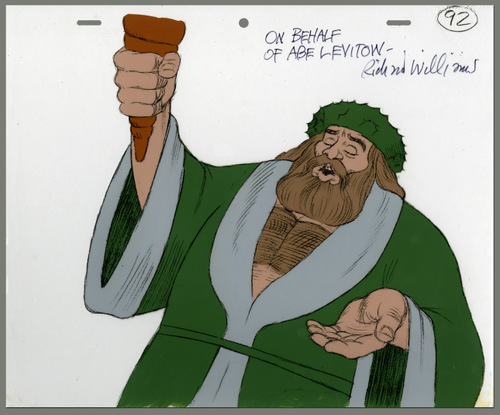 By this time, Williams had developed something of a name within the world of animation. Strong and important animation figures went to his studio to work for periods of time. Someone like Abe Levitow taught and animated for the studio. (His scenes for The Christmas Carol are among the most powerful.) Many of the Brits that worked in the studio and then left to start their own companies were now among the world’s best animators.
By this time, Williams had developed something of a name within the world of animation. Strong and important animation figures went to his studio to work for periods of time. Someone like Abe Levitow taught and animated for the studio. (His scenes for The Christmas Carol are among the most powerful.) Many of the Brits that worked in the studio and then left to start their own companies were now among the world’s best animators.
Williams had the opportunity of doing a theatrical feature adaptation of the children’s books The Adventures of Raggedy Ann and Andy and took it. A large staff of classically trained animation leaders such as Art Babbitt, Grim Natwick, Tissa David, Hal Ambro, Emery Hawkins and many others worked out of New York or LA as the company set up two studios to produce this film. Working for over two years, Dick’s attention was diverted to work away from his London studio, where commercials and some small devotion was given to The Thief by a few of the key personnel working there. Dick spent a good amount of his time in the air flying from NY to LA to NY to London and back again and again. He concentrated his animation efforts on cleaning up animation by some of the masters, rather than allow proper assistants to do these tasks. By doing this he was able to reanimate some of the work he didn’t wholly approve of. Entire song numbers were reworked by Dick as the film flew well behind its budget and schedule.
Eventually, the film finished in confusion and mismanagement, and Dick moved to his LA studio where he continued commercials and began Ziggy’s Gift, a Christmas Special for ABC.
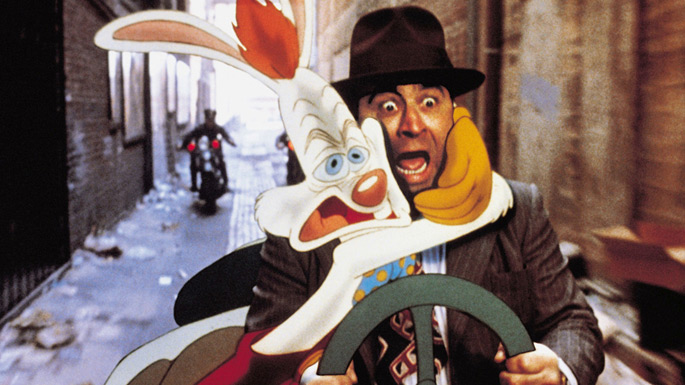 From this he went back to his London studio and did the animation for Who Framed Roger Rabbit for producer/director Robert Zemeckis. He hoped that work on this feature, which won three Academy Awards, including a special one for the animation, would be the triumph he needed to help him raise the funds for The Thief and the Cobbler. Now that he was safely back in his own studio in Soho Square he felt more focused.
From this he went back to his London studio and did the animation for Who Framed Roger Rabbit for producer/director Robert Zemeckis. He hoped that work on this feature, which won three Academy Awards, including a special one for the animation, would be the triumph he needed to help him raise the funds for The Thief and the Cobbler. Now that he was safely back in his own studio in Soho Square he felt more focused.
A contract came from Warner Bros., and the work began in earnest.
Dick’s history wasn’t the best working on these long form films. Chuck Jones replaced him on The Christmas Carol to get it finished when work went overbudget and schedule. Dick was putting too much into it. Gerry Potterton finished Raggedy Ann when the budget went millions over with less than a third completed. Eric Goldberg took over Ziggy’s Gift, the Christmas Special for ABC, to get it done on time. On Roger Rabbit, the live action director stayed intimately involved in the animation after his shoot was complete. When it became obvious that things weren’t going well, he stepped in to complete that film.
In all cases of all of these films, Dick never left. He stayed on working separately on animation or assisting to try to keep a positive hand in the quality of the work that was done.
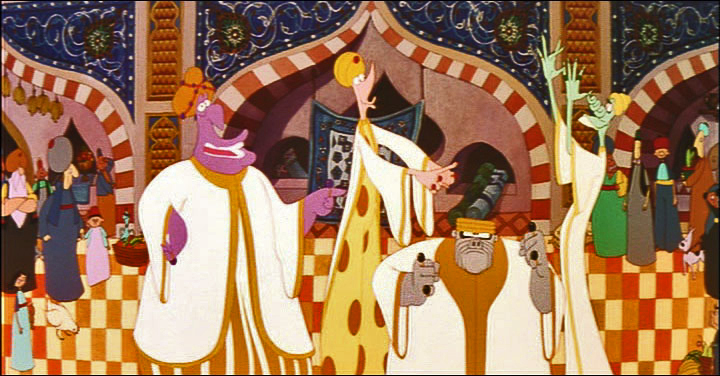 When The Cobbler and the Thief ran into very serious trouble, there was no secondary Director or Producer to come in and complete the work. Instead that job fell to the money men. The completion bond company, essentially an insurance company for Warner Bros. to make sure they wouldn’t lose their money if things didn’t go well, stepped in. They closed Dick’s studio and removed Dick from the premises. The boxed up and carted off all animation work done or in progress. It was all moved back to Los Angeles.
When The Cobbler and the Thief ran into very serious trouble, there was no secondary Director or Producer to come in and complete the work. Instead that job fell to the money men. The completion bond company, essentially an insurance company for Warner Bros. to make sure they wouldn’t lose their money if things didn’t go well, stepped in. They closed Dick’s studio and removed Dick from the premises. The boxed up and carted off all animation work done or in progress. It was all moved back to Los Angeles.
The Weinsteins, through their company, Miramax bought the film at auction and completed it with a poor excuse of an animation outfit they set up in LA. Work was also sent to Taiwan. The script was reworked trying to capitalize on the success of Disney’s Aladdin that had recently opened in the US. If Robin Williams‘ ad libbing could be such a success, imagine how well Jonathan Winters could do repeating that for a character who, in Dick’s original version, had no voice. Now he didn’t stop talking.
The new film failed miserably and deserved to do so. The primary audience, I would suspect, was the entire world animation community coming to look down on the artificially breathing corpse.
 Richard Williams, himself, retired and moved far from the mainstream. He continues to work on small animation bits, but his primary work has been in making a series of DVD lectures revealing how animation should be done. This accompanies a well-received book he wrote and illustrated. Meanwhile, the animation community still hopes that something will emerge from that corner.
Richard Williams, himself, retired and moved far from the mainstream. He continues to work on small animation bits, but his primary work has been in making a series of DVD lectures revealing how animation should be done. This accompanies a well-received book he wrote and illustrated. Meanwhile, the animation community still hopes that something will emerge from that corner.
Dick turns 80 years old on March 19th. He’s still an amazing forceful and exciting personality. I wish I had more access to him (as does most of those who knew him back then.) He’s had probably the greatest effect on the animation industry of anyone since the late sixties. There are still studios thriving today on information they learned from Dick and his teaching.
If you’re unfamiliar with the blog, The Thief, I suggest you take a look.
Animation &Errol Le Cain &Richard Williams 09 Apr 2012 08:23 am
The Sailor and the Devil – repost
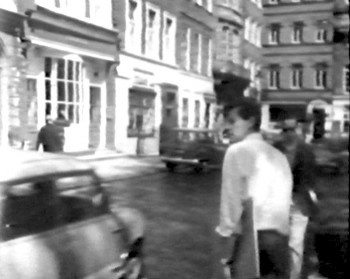 - There was a documentary about Richard Williams that I saw many years ago on PBS. It made me an ardent enthusiast of Williams’ work, and I followed his trajectory over many years. Eventually, I worked with him.
- There was a documentary about Richard Williams that I saw many years ago on PBS. It made me an ardent enthusiast of Williams’ work, and I followed his trajectory over many years. Eventually, I worked with him.
The show was called The Creative Person: Richard Williams and was made in 1966. Within the show was a very small section about one of Williams’ artists, Errol LeCain. He was given the task of making a film 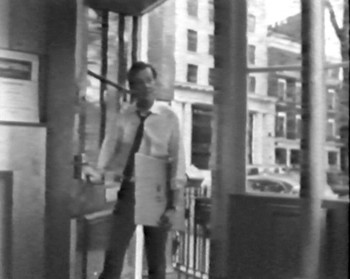 by himself. As Williams explains, this would teach him all the aspects of animation filmmaking and the studio would gain a short film in the end.
by himself. As Williams explains, this would teach him all the aspects of animation filmmaking and the studio would gain a short film in the end.
The film was called The Sailor and the Devil. This is probably the only film done by the Williams Studio that I haven’t seen. It’s still not on YouTube. Hans Bacher gave some color images on his site, one1more2time3, a year ago. Wanting more, I went back to the special and made frame grabs of some of the film, and I’m posting them here.
Dick was so young, as was Errol LeCain. He went on, of course, to become a world-class children’s book illustrator and the original designer of the backgrounds for the ill-fated Cobbler and the Thief.

Errol LeCain
Commentary &Errol Le Cain 29 Oct 2011 05:19 am
Rumblings
- I’ve been an ardent admirer and promoter of Errol Le Cain‘s work. I’ve followed him since the early 60s when I first saw a documentary on Richard Williams who’d assigned Le Cain a film, The Sailor and the Devil. I’d also featured many of his illustrated books on my blog. In doing such, I’ve received a number of comments from people over the year. This week I received one that I’d like to share with you:
- Dear Michael
The Eurasian Association in Singapore is exploring the possibility of setting up a permanent exhibition of the works of Errol Le Cain with a thorough biography from the early days of his childhood. ELC was both a Eurasian and brought up in Singapore. I actually have Errol Le Cain’s early life up to 1956 well covered. Will
be making for interesting reading when done, with some good photos too. It is his life and working life in England from1956 till 1989 that has patches and is missing many details.
I am writing to ask your help to please publish on your website our appeal for facts about his life and work and for scans at 300dpi of any unpublished illustrations or artwork by Errol Le Cain.
I have the blessings of his widow Lili Le Cain to do this, and there are still people alive who remember him and his family in Singapore; and many who collaborated with him during his most fruitful time in England. But the time to gather facts is quickly passing. At last I’m getting the replies that make research so satisfying. Inter alia, I found out that ELC’s father had been incarcerated by the invading Japanese in the notorious Changi Prison and was lucky to have escaped with his life.
Here is a little gem: when Errol sat for his Cambridge leaving exam, he finished his art paper in 20 minutes instead of the 3 hours allotted, so the invigilators (who were from another school) reported the matter which had to be investigated for cheating! Of course he was fully exonerated and his mark was an A1.
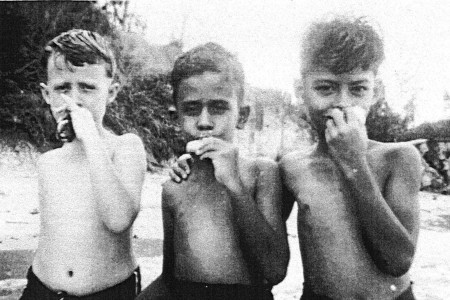
Attached is a very early photo of Errol Le Cain
in happy times with friends by the sea.
Please assist me to gather everything we can of the life and art of Errol Le Cain which should be available to the world, and not just a privileged few.
If anyone has any information about Errol Le Cain’s early life in Singapore, please don’t hesitate to write about it.
.
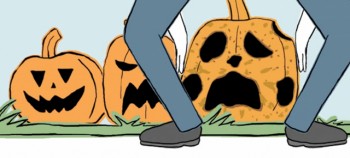
- Slingshot TV is a new website designed to show off new independent animated films, cartoons and art. The hope to fund, produce and distribute original work and publish articles and information to help independent artists “work better and smarter in the digital age.”
Currently, they have three shorts by Danny Dresden up and running. They’ve just begun.
If you want to contact them about a project you’re working on, or have a general inquiry please email them at slingshot.tv@gmail.com.
.
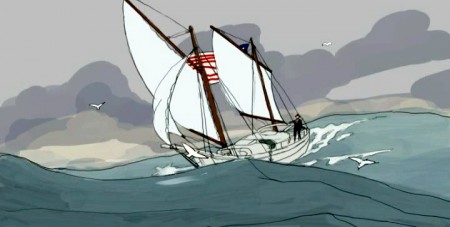
- On Thursday, Dec. 1st there will be an Evening with Paul & Sandra Fierlinger
at the Kelen Auditorium,
66 Fifth Avenue at 13th Street in NY.
The program will consist of a screening and discussion of their documentary animation films and a discussion of the plans they have for the online distribution of their new feature film project, Slocum at Sea with Himself.
I’ve seen about ten minutes of this film and can attest that it is some of their finest work. You’ll want to see it, and I’ll remind you of this as the date gets closer. You should mark it off on your calendar as an important event.
This program is presented by the Illustration Program at Parsons, the New School for Design.
.
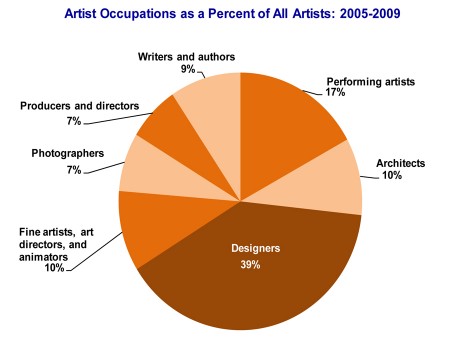
.
- The National Edowment for the Arts has done some research on the Arts professions, and the information is available on line. Some of the information you can see includes:
-
* There are 2.1 million artists in the United States. They make up 1.4 percent of the total workforce, and 6.9 percent of the professional workforce (artists are classified as “professional workers”).
* More than one-third of artists in the survey (39 percent, or 829,000 workers) are designers (such as graphic, commercial, and industrial designers, fashion designers, floral designers, interior designers, merchandise displayers, and set and exhibit designers.)
* Performing artists make up the next largest category (17 percent). In addition, each of the following occupations make up 10 percent of all artists: fine artists, art directors, and animators; writers and authors; and architects.
* Between 2000 and 2009, the artist labor force increased by 5 percent while the civilian labor force grew by nearly 8 percent.
It’s quite an extensive survey available here.
.
.

Finally, I have to say that I really enjoy Signe Baumane‘s blog, Rocks in My Pocket. It’s supposed to be built around the animated feature Signe’s creating with its 2D animation moving in front of the 3D sets she is constructing. However, it is really about the everyday life in the world of an artist trying to create a new world. As such we get plenty of the current day problems, but we also get stories of the past life (which obviously affects the current). It’s always a great read – as opposed to many of the self-important blogs I trudge through. The stories are always well written, and the imagery is just a delight.
Animation &Errol Le Cain &Independent Animation &Richard Williams 04 Sep 2010 07:35 am
The Sailor & the Devil
 - There was a documentary about Richard Williams that I saw many years ago on PBS. It made me an ardent enthusiast of Williams’ work, and I followed his trajectory over many years. Eventually, I worked with him.
- There was a documentary about Richard Williams that I saw many years ago on PBS. It made me an ardent enthusiast of Williams’ work, and I followed his trajectory over many years. Eventually, I worked with him.
The show was called The Creative Person: Richard Williams and was made in 1966. Within the show was a very small section about one of Williams’ artists, Errol LeCain. He was given the task of making a film  by himself. As Williams explains, this would teach him all the aspects of animation filmmaking and the studio would gain a short film in the end.
by himself. As Williams explains, this would teach him all the aspects of animation filmmaking and the studio would gain a short film in the end.
The film was called The Sailor and the Devil. This is probably the only film done by the Williams Studio that I haven’t seen. It’s still not on YouTube. Hans Bacher gave some color images on his site, one1more2time3, a year ago. Wanting more, I went back to the special and made frame grabs of some of the film, and I’m posting them here.
Dick was so young, as was Errol LeCain. He went on, of course, to become a world-class children’s book illustrator and the original designer of the backgrounds for the ill-fated Cobbler and the Thief.

Errol LeCain
Books &Errol Le Cain &Illustration 09 Jan 2010 09:33 am
Le Cain’s Growltiger – 2
- I’ve not paid much attention to Errol LeCain lately, so I thought it might be amusing to revisit a book that I only touched on in the past. Le Cain illustrated two books out of T.S. Eliot’s book of poems, Old Possum’s Book of Practical Cats. See the first post here.
In one of the two books, Growltiger’s Last Stand, three of the poems are illustrated. In my initial post, I only offered the illustrations from one of the the three. To amend for that, this post will include illustrations from the other two.
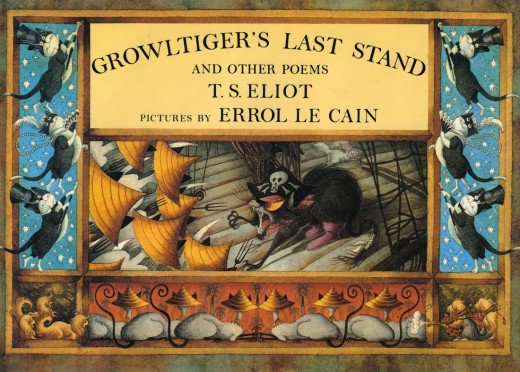
(Click on any image to enlarge.)
.
Of the Awful Battle of the Pekes and the Pollicles
The Song of the Jellicles
Books &Errol Le Cain &Illustration 04 Apr 2009 09:14 am
LeCain’s Pied Piper recap
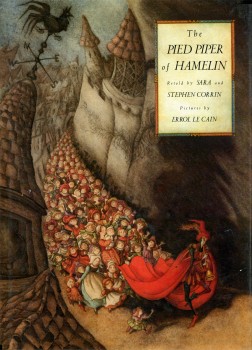 - After learning that Don Bluth et al were planning to do a film called “The Piper” prior to their working on Banjo: the Woodpile Cat, I wondered and assumed that it was probably The Pied Piper of Hamelin.
- After learning that Don Bluth et al were planning to do a film called “The Piper” prior to their working on Banjo: the Woodpile Cat, I wondered and assumed that it was probably The Pied Piper of Hamelin.
Many years ago as a child, I received a gift of a viewmaster projector, and it came with one title: The Pied Piper of Hamelin. Those slide shows usually came with a script that you could read along with each projected slide. I remember that this one came with the lengthy Browning poem. Reading it to myself, I loved it. So I memorized it (and still remember now some fifty years later.
I’ve always been attracted to versions of this story and often seek them out.
Errol Le Cain‘s illustrated a version of the poem, and here are some images from the book, The Pied Piper of Hamelin. It was first published in 1989 (the year he died). The book is an adaptation of Browning’s poem by Sara and Stephen Corrin.
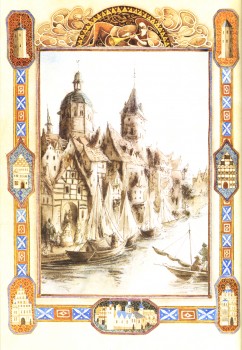
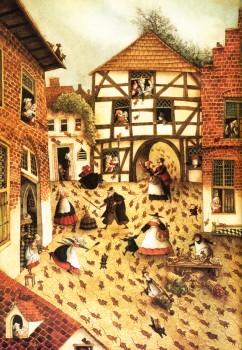
(Click on any image to enlarge.)
Books &Errol Le Cain &Illustration 11 Sep 2008 08:05 am
A School Bewitched – pt.2
 - Here I continue with the illustrations by Errol Le Cain for the book written by Naomi Lewis from a story by E. Nesbit.
- Here I continue with the illustrations by Errol Le Cain for the book written by Naomi Lewis from a story by E. Nesbit.
A School Bewitched is a small picture book with a full page illustration on every other page. The remainder have spots which decorate around the type.
Again, my focus here (and yesterday) is to show off the illustrations. I’m not concerned with telling the story. I’d urge you to buy the book if you’re interested in that.
______(Click any image to enlarge.)
 16
16 17
17
